1945-1955,
DE L’ABSTRACTION AU LYRISME
September / October 2017
What an honour it is to be exhibiting Schneider’s work at the gallery again!
In the great publishing adventure of the Catalogue Raisonné (1896-1986), it has become essential to present a pivotal decade: 1945-1955, a crucial period during which Schneider’s experimental geometric abstraction evolved towards the affirmation of a lyrical style that was very pioneering, personal and powerful in which the forms mastered were replaced by a nervous gesture, exalted, confident and free.
1945-1955: From Abstraction to Lyricism!
Diane de Polignac & Astrid de Rendinger
The exhibition being presented by Diane de Polignac is without any doubt a first because it shows works by Gérard Schneider created exclusively from 1945, so he end of the war, to 1955. The reach of these paintings is evident and this applies for the entire period of ten years or so of aesthetic unity and diversification. So many permanent advances in his visual and colour investigations. It becomes obvious to us that during these years, his painting, an avalanche of emotions, evolved ceaselessly, brilliantly, from the first angular forms. Some remain close to this straightness without being entirely distant from the figurative subject (cf. OPUS 2681, 1945). The first more gestural endeavours also appear during this period and quickly take over, as early as 1947 (cf. OPUS 3502). Finally, the lyrical definitively overcomes methodical rigour. Warmth defeats cold! There, the artist incites the encounter, even the shock of the two languages of austere structure and liberated gesture. From then on, without ever being overly eloquent, Gérard Schneider was no less an exalted painter, but always one in control. Evoking his frenzy for painting, he simply invoked the visual image of his emotion and his instinct.
Schneider’s place in history cannot be denied. He is one of the very few pioneers of lyrical abstraction of which the aura that had disappeared for a time, returned to us a few years ago with exhibitions of the highest order. If Schneider, Hartung and Soulages are its emblematic figures, the real innovators, naturally, they don’t have any less highly diversified identities. The oldest among them, Gérard Schneider, enjoyed transcribing onto a canvas the “lyrical forces that sing in him”. His subconscious spontaneously guided the gesture he printed with a brush filled with colours that were most often bright. This continued to be obvious up to his death in 1986!
I had the opportunity of meeting Gérard Schneider during the last ten years of his life. Our conversations were of course about painting and his painting, but he most often enjoyed talking about poetry and music, a lot of music, of which he was a fine connoisseur. Regarding his painting, he showed it much more than he talked about it, benevolently allowing the visitor to appreciate and comment on his work freely. Schneider was an affable man, measured, independent and profoundly free. He was in full possession of himself, guided by a unique desire: the act of painting. He enjoyed emphasizing that a work must resolve the conflicts of its author to the extent that the author becomes conscious of the sources of his inspiration. Lastly, we should remember that his permanent restraint, doubled with an accurate view towards others always earned him obvious respect in the art world that was clearly justified.
Patrick-Gilles Persin
1 Ill. p.19.
2 Ill. p.27.
Gérard Schneider
Painting in flight
Dominique Gagneux
Chief Curator of Heritage
For Gérard Schneider’s art, the years 1945-1955 are crucial. A year before this decade began in fact he made the decisive leap towards abstraction, creating his first “Abstract composition” at the end of a long process that had begun with rigorous training and a careful study of the old masters.
It is said – rightly – about Gérard Schneider that he is a painter of lyrical abstraction, prioritizing the forms born from a gesture that is emphasized by the feeling of speed, the spontaneous urgency of creation, using the palette knife and the brush. We often forget that he was not quite of the same generation as Hartung (born in 1904), Soulages (born in 1919) and Mathieu (born in 1920) and that as early as the 1930s, he had built up a body of work that shows the essential beginnings of a move towards the abstract that, like for Kandinsky and Mondrian, came from real shapes. During the interwar period, he had already exhibited at the Salon d’Automne and at the Surindépendants. During those years of apprenticeship, he learned the fundamentals of his art copying Watteau, looking at Courbet, Delacroix and Cézanne a lot who brought him, as a critic has commented, a “clear desire to depict a group of perceptions in the order of a general impression”.1 During this period of training, he experimented with various movements, while continuing to study progressive abstraction (which he set apart from the abstract). Some of these founding works evoke the combative forms of Franz Marc or the drawings of Paul Klee. He allowed himself to be attracted for a time by Surrealism (1937-38), finding inspiration in the same sources as the American Abstract Expressionists.2 At that time, while he was clearly moving towards nonfigurative tendencies, the titles still evoked a certain reality: Monsters, Pastoral Music, Masks.
After the war, very naturally therefore with a new generation of artists and critics, gallerists and collectors, Gérard Schneider participated in the domination of an art form that was completely released from the direct viewing of nature. After the Liberation of France, Paris renewed its intense artistic activity and remained a centre that was favourable to exchanges, in which artists from a wide variety of origins and manners converged. There, abstract art appeared however as a form of art that was lifeless, foreign to a national tradition whose great personalities were Matisse, Braque and Picasso. Opposite them, a young generation of painters of reality grouped around the Salon de la Jeune Peinture and the Manifeste de l’Homme Témoin,3 which enjoyed unprecedented success, communicating a humanist message with force and austerity, describing the profound reality of their everyday and defending “real painting”. Also opposite them, the offensive of socialist realism that sought to impose its system of ideological representation.
However, abstract art progressively conquered the art world until it became the dominant movement. Its exhibition venues multiplied, such as the Salon des Réalités Nouvelles which opened in July 1946 and united in a common front all the tendencies of what is called “concrete non-figurative art or abstract art”. Young galleries were opened, benefitting from great dynamism in the art market, Denise René (1944), Maeght (1945), Colette Allendy (1946), Lydia Conti (1947). The journals Art d’aujourd’hui and XXème siècle analysed abstract art in fundamental articles written by its champions Léon Degand, Charles Estienne, Michel Ragon and Roger van Gindertael. Major exhibitions soon clearly integrated this tendency into a history of modern art that was being written at the time, such as in Spring 1949, Les Origines de l’art abstrait at the Galerie Maeght.
Schneider participated in this intense activity, and was himself supported by the art critics Madeleine Rousseau and Jean-José Marchand. He was part of a group exhibition at the Research Centre of the Rue Cujas created by César Domela (1946). At the first salon des Réalités Nouvelles, he attracted the attention of Léon Degand, René Guilly and Charles Estienne.
The same year, he exhibited for the first time with Deyrolle, Dewasne, Marie Raymond and Hartung at Denise René’s gallery which was then on the rue de Miromesnil and did not yet concentrate on the exclusive defence of geometrical abstraction. In 1947, Lydia Conti organized Gérard Schneider’s first solo exhibition. With Hans Hartung and Pierre Soulages, whom he had met respectively in 1947 and 1949, he formed a trio whose style was similar and they exhibited together.
Hartung mentions in his memoires that at that time, they had all “developed in an instinctive and natural manner”.4 At the end of the 1940s, Schneider was an important abstract painter whose career had taken on an international range (he exhibited at the Venice Biennale in 1948 and 1954, with Betty Parsons in New York in 1948, in Germany at the exhibition Französische Abstrakte Malerei,5 benefitted from a retrospective at the Brussels Fine Arts palace in 1953, and two years later, the American gallerist Samuel Kootz, signed a contract with him after Soulages and Mathieu).
Without any doubt, in the immediate post-war period, the liberation of the form achieved by these artists accompanied liberty regained, the gesture of which is the symbol. The spontaneity of the creative act was highlighted, corresponding the most completely with the profound desire to “start again from scratch”.6 In their need for classification, the critics did not delay in inventing terms to define this new avant-garde with its multiple aesthetic principles. In this way, this very free art took on the names of “lyrical”, “tachiste” and “informal”, and became associated with personalities who were as varied as Wols, Fautrier, Atlan, Hartung and Schneider. Even more than geometric abstraction, which was cold and built up in planes of colour – a temptation to which Gérard Schneider succumbed for a time in a dream of mural painting – the gestural work, resulting from a group of strokes with the paint brush, or blots, or lines, appears like a return to automatism, the practice that was best adapted to the desire to break with the past.
Schneider, as a representative of integral abstraction, stands out with his works that are full of movement: “the gesture is the direct technical means for the realisation of a lived moment. It is the gesture that under the influence of interiority, creates the form.” His broad graphic manner is often evoked, the colours applied with emphasis and confidence. His dynamic handling, like the relationship he develops between his forms and shades of colour, are all the more expressive in that his painting, in which the material’s essence is fundamental is often founded on opposites. Looking at a painting by Gérard Schneider, the viewer experiences a confrontation of skilfully orchestrated vehemences. These tormented rhythms are nevertheless balanced and submitted unconsciously to principles of composition that have come from the attention he paid to Cezanne and Cubist painting. Often, the blacks structure the composition, forming a dialogue with a dominant white, a bright colour and a palette of subtle colours, all superimposed and transparent due to a technique with glazes. A film from 19697 shows Gérard Schneider at work. We see an art of speed in which the abrupt, quick gesture is also syncopated, sometimes suspended and concentrated… In this world of creation the painter favours, like the surrealists, the vital free momentum, but which is controlled, chancy but directed by the unconscious. In the manner of Hans Hartung who had the strange practice of spontaneous preparatory drawing carefully reproduced on the canvas, a method that could on occasion be practiced by Schneider. But the essential element of this artist is physical in nature, consisting of reinstating an emotion by the style, of expressing his personality.
The search for expression is the major characteristic of the painting of Gérard Schneider. This quest for transcendence, this departure from nature and the object serves a work for which the subject lies in its interiority, in the emotion that guides the hand.
The external elements that have become useless is replaced by this internal necessity dear to Kandinsky and which Schneider describes with his own words: “Poetic painting, painting of feelings, the whole range of feelings that open up to the internal life.”
The very notion of lyricism also contains this poetical tendency favouring subjectivity. What is essential in this abstraction does not result as much from a completely free manner of creation as giving consideration, with acuity, to an exaltation and effusion of feelings. How do you resolve this contradiction of oxymoron between non-representation and sensitivity? How do you take into account a painting that expresses liberty, sadness, nostalgia, the spiritual? By plastic means noted by Charles Estienne in 1946, the “play of values of greys and blacks a sort of depth, an additional depth born perhaps of new relations between the body and the mind..” But above all by a direct improvisation that cannot be explained. By the necessary expression of an emotional state rendered by a “painting of action”, which seeks to communicate an equivalent reaction to the viewer.8 This need to “descend into the depths of himself like a diver” to repeat the beautiful expression of Henri-Pierre Roché writing about Wols, allows the recreation, like a cry, of the crucial moment of an emotion in its purest intensity.
In the work of Gérard Schneider the same close relation exists between his work and music as it does for other abstract artists. From 1945 on, he titled his paintings “composition” or “opus”, followed by a number that places the work in his overall oeuvre. When Schneider analysed Courbet’s painting, he used the musical term of vibrato to describe his technique with the palette knife. He himself evoked the genre of improvisation or sonata to define some of his own ink drawings.
But when an abstract painter refers to this form of art, it is not just a question of vocabulary or surface analogies. Relations between music, an art of time, and painting, an art of space, are structural, as the pioneers of abstraction Kandinsky and Klee have studied them. They spoke of harmony and resonance, of rhythm, intensity and dynamic. In its absence of narrative, abstract painting made of shapes, colours, and signs liberated from any imitation of nature, finds natural parallels in music. And by its temporal articulation such a work is in a position to create a flow that is musical in nature. In a painting by Schneider, the coloured marks applied with a broad brush and the paint, allow its development process to be understood. It is then possible to perceive the nature of the gesture, to capture its speed and rhythm retrospectively.
But, we understand this, it is the sensitivity that is the dominant factor in a Schneider painting, and the chromatic combinations contribute to the expression: “it is essential to see abstract painting like we listen to music, feel the emotional interiority of the work without seeking to find in it an identification with a figurative representation”. Music allows emotions to be communicated like abstract painting allows internal resonances to be translated by a quality that touches. In this way for Schneider, red produces an effect, black is a contained strength, its discretion allows him to rebalance the colours. As he says, his taste “is sound like a tam-tam”.
In his pamphlet published in 1950 “L’art abstrait est il un académisme ?”9, Charles Estienne asked young painters: “Are you artisans or poets?” Without any doubt, Gérard Schneider answers both terms of this question in the positive. He had been a painter decorator and restorer of old master paintings, and also a poet at the same time, when in a moment of pure gushing, he allowed himself to be guided by the same internal necessity, establishing obvious correspondences with his painted work:
And here
Figure of the world
That crosses
The painful light
And this other
Image of darkness
That nothing persuades10
1 Roger van der Gindertael, Art d’aujourd’hui, series 2, n°6 June 1951, p. 26-27.
2 Michel Ragon compares Schneider’s art with that of Franz Kline and Willem de Kooning, in Schneider, Angers, Expressions contemporaines, 1998.
3 On 21 June 1948, the critic Bouret launched the « Premier Manifeste de l’Homme témoin », at the Galerie du Bac in Paris. Breaking with contemporary art, especially the abstract, he favoured the human and the real calling on the adoption of « an intelligible language ».
4 Hans Hartung, Autoportrait, Paris, Bernard Grasset, 1976, p.38.
5 This travelling exhibition was organized in Germany by Dr Domnick, a psychiatrist in Stuttgart and collector.
6 “We actually began, so to speak, from scratch, as if painting were not only dead but never existed.” It is an expression by the American artist, Barnett Newman. It is also the title of an exhibition organized at the Lyon Musée des Beaux-Arts from 24 October 2008 to 2 February 2009.
7 Gérard Schneider: éléments bruts, Atelier 70, RTF / ORTF, Producer: Roger Bertin, first broadcast on 01/01/1969.
8 The expression comes from Charles Estienne in Hans Hartung, Autoportrait, Paris, Bernard Grasset, 1976, p.180..
9 Charles Estienne, L’Art abstrait est-il un académisme?, Paris, Éditions de Beaune, 1950, p.6.
10 Gérard Schneider, Mots au vol, Paris, Éditions Saint-Germaindes-Prés, 1974, p.51.
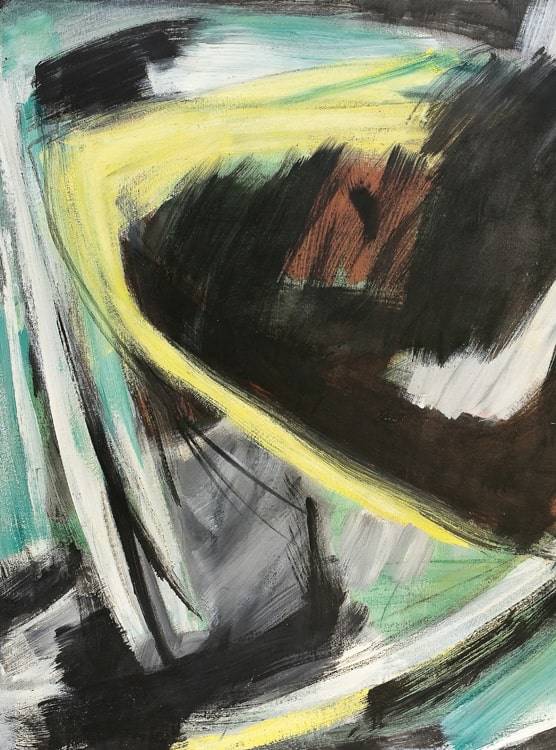 Opus 65 B (détail), 1954
Opus 65 B (détail), 1954(Repr. p.69)

Galerie Lydia Conti (en vitrine : à gauche une toile de Gérard Schneider, à droite une toile de Hans Hartung), Paris, 1948
Photographie : DR – © Archives Gérard Schneider.
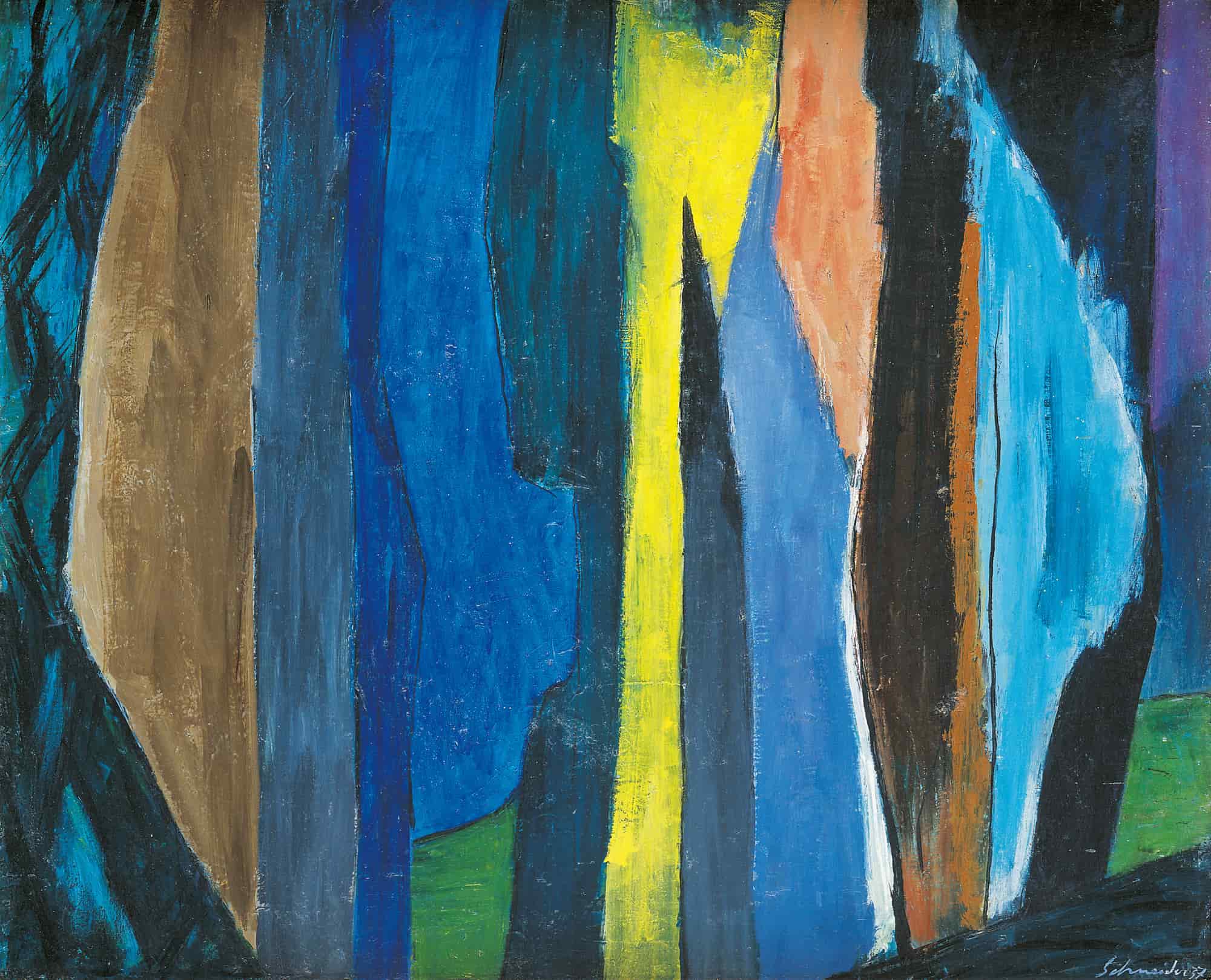
Opus 80, 1937
Oil on canvas
60 x 73 cm. / 23.62 x 28.74 in.

Paysage imaginaire, 1937-1939
Oil on canvas
54 x 65 cm. / 21.26 x 25.6 in.
WORKS

Sans titre , 1945
Oil on canvas
55 x 46 cm. / 21.65 x 18.11 in.
Signed & dated in the lower middle
Private collection
Exhibition
Galerie Denise René, Paris, France, 1945
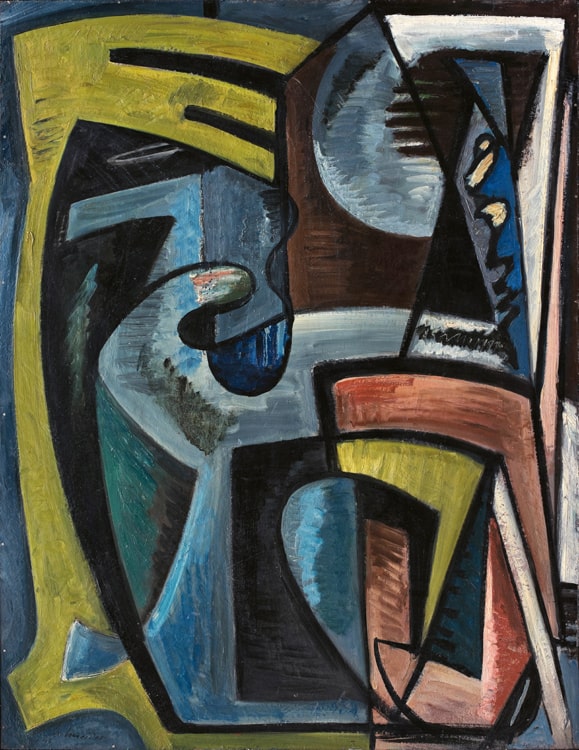
Opus 268, 1945
Oil on panel
130 x 100 cm. / 51.18 x 39.37 in.
Signed lower left
Private collection
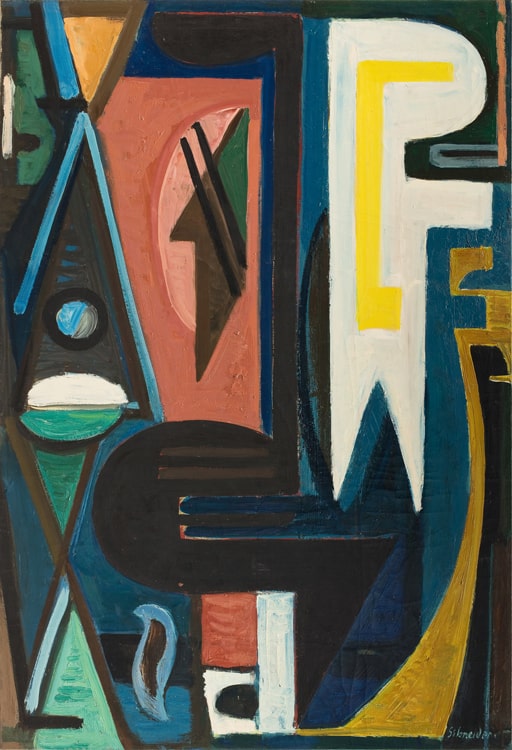
Opus 271, 1945
Oil on canvas
130 x 97 cm. / 51.18 x 38.19 in.
Signed lower right
Private collection
Exhibition
Salon des Surindépendants, Paris, France, 1945

Opus 270, 1946
Oil on canvas
130 x 89 cm. / 51.18 x 35.04 in.
Signed & dated lower right
Private collection
Exhibition
Salon des Surindépendants, Paris, France, 1946

Opus 310, 1946
Oil on canvas
81 x 65 cm. / 31.89 x 25.59 in.
Signed lower right
Private collection
Exhibition
Galerie Lydia Conti, Paris, France
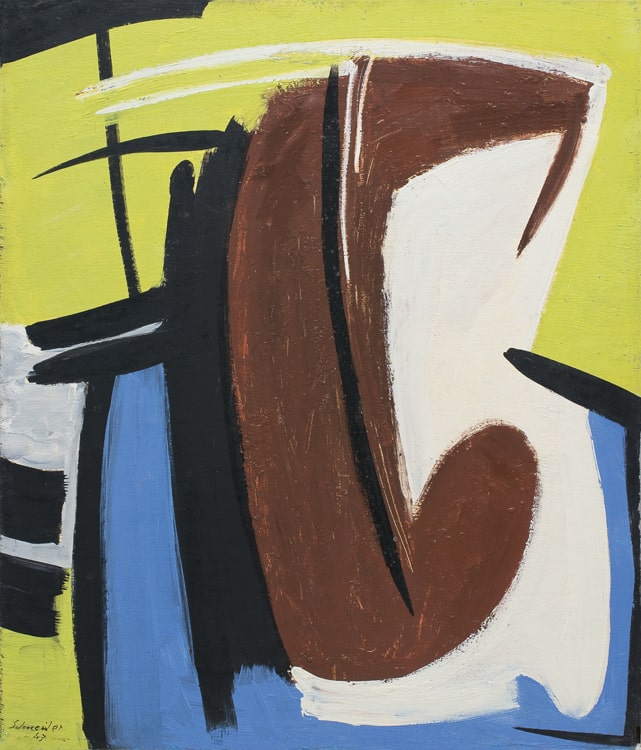
Opus 350, 1947
Oil on panel
65 x 54 cm. / 25.59 x 21.26 in.
Signed & dated lower left
Private collection
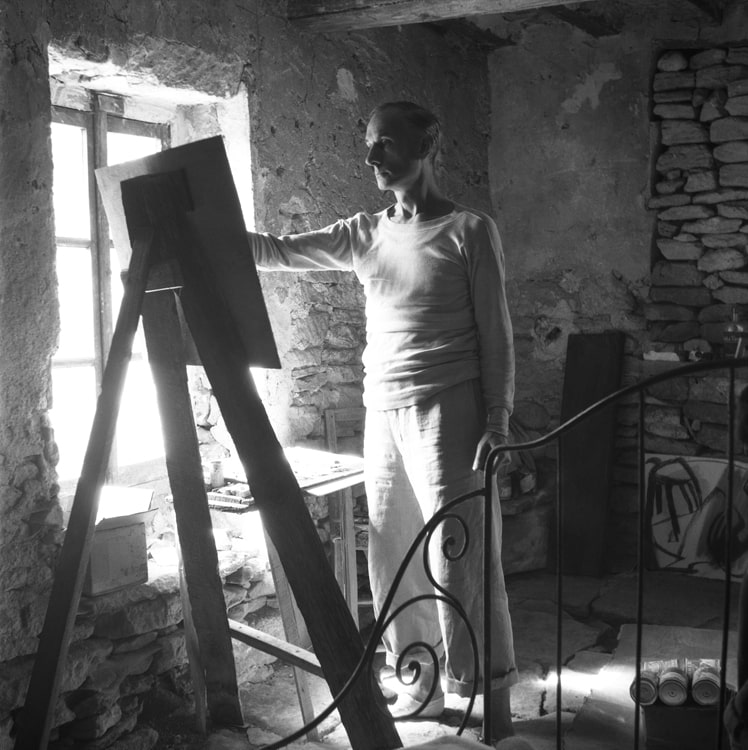
Gérard Schneider, Gordes, France, 1947 ca.
Photographie : DR – © Archives Gérard Schneider.
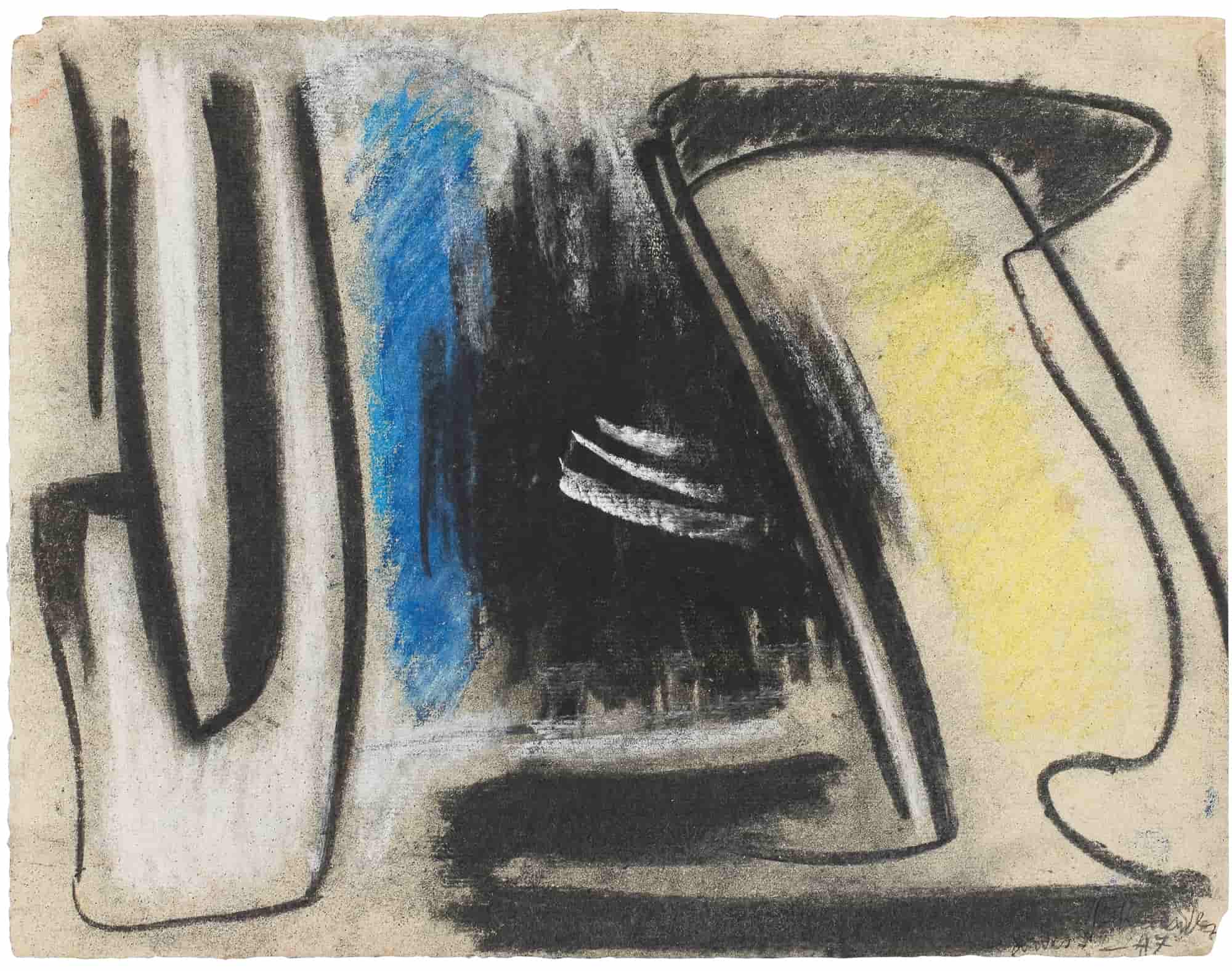
Sans titre, Gordes, 1947
Charcoal & chalk on paper
24,5 x 31,8 cm. / 9.65 x 12.52 in.
Signed, situated & dated lower right
Private collection
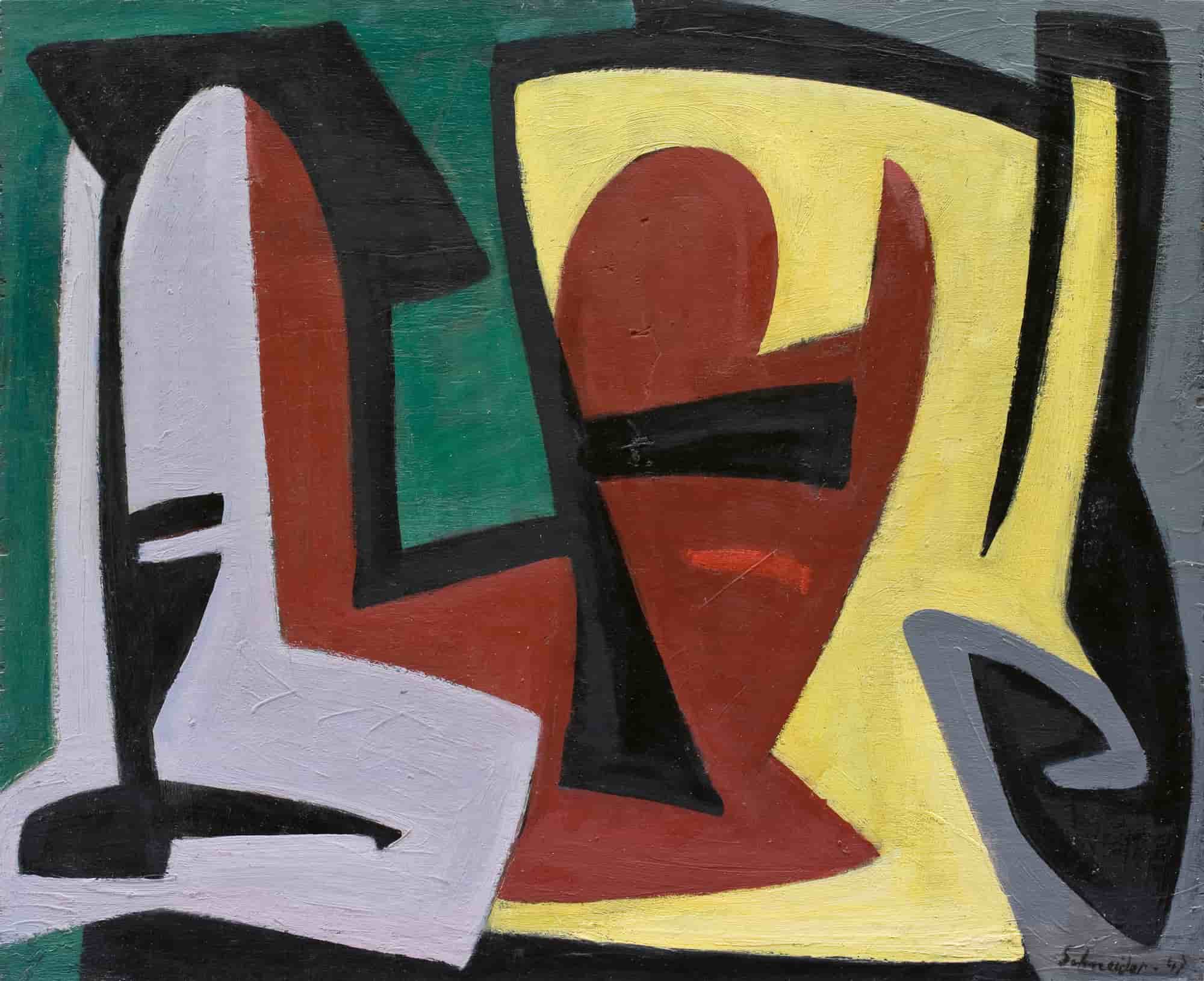
Opus 343, 1947
Oil on panel
50 x 61 cm. / 19.69 x 24.02 in.
Signed & dated lower right
Private collection
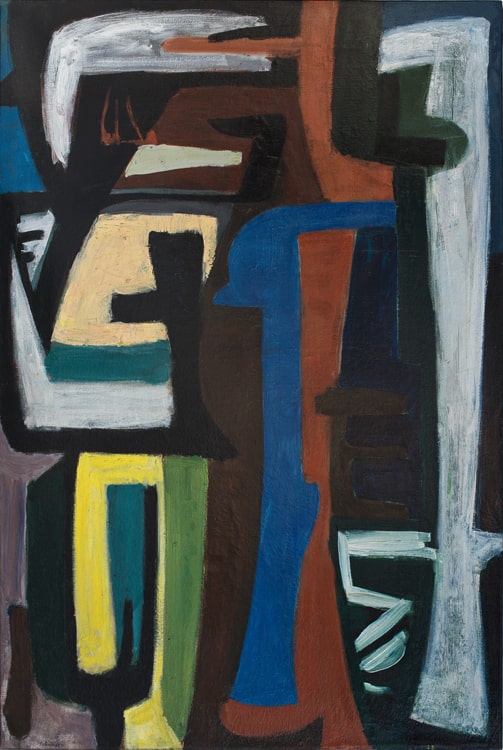
Opus 321, 1948 CA.
Oil on canvas
146 x 95 cm. / 57.48 x 37.4 in.
Signed lower left
Private collection
Exhibitions
Gérard Schneider, Kunstverein Düsseldorf, Allemagne, 20 mars – 23 avril 1962, cat. n°14
Gérard Schneider, Palais des Beaux-Arts, Bruxelles, Belgique, juin 1962, cat. n°14
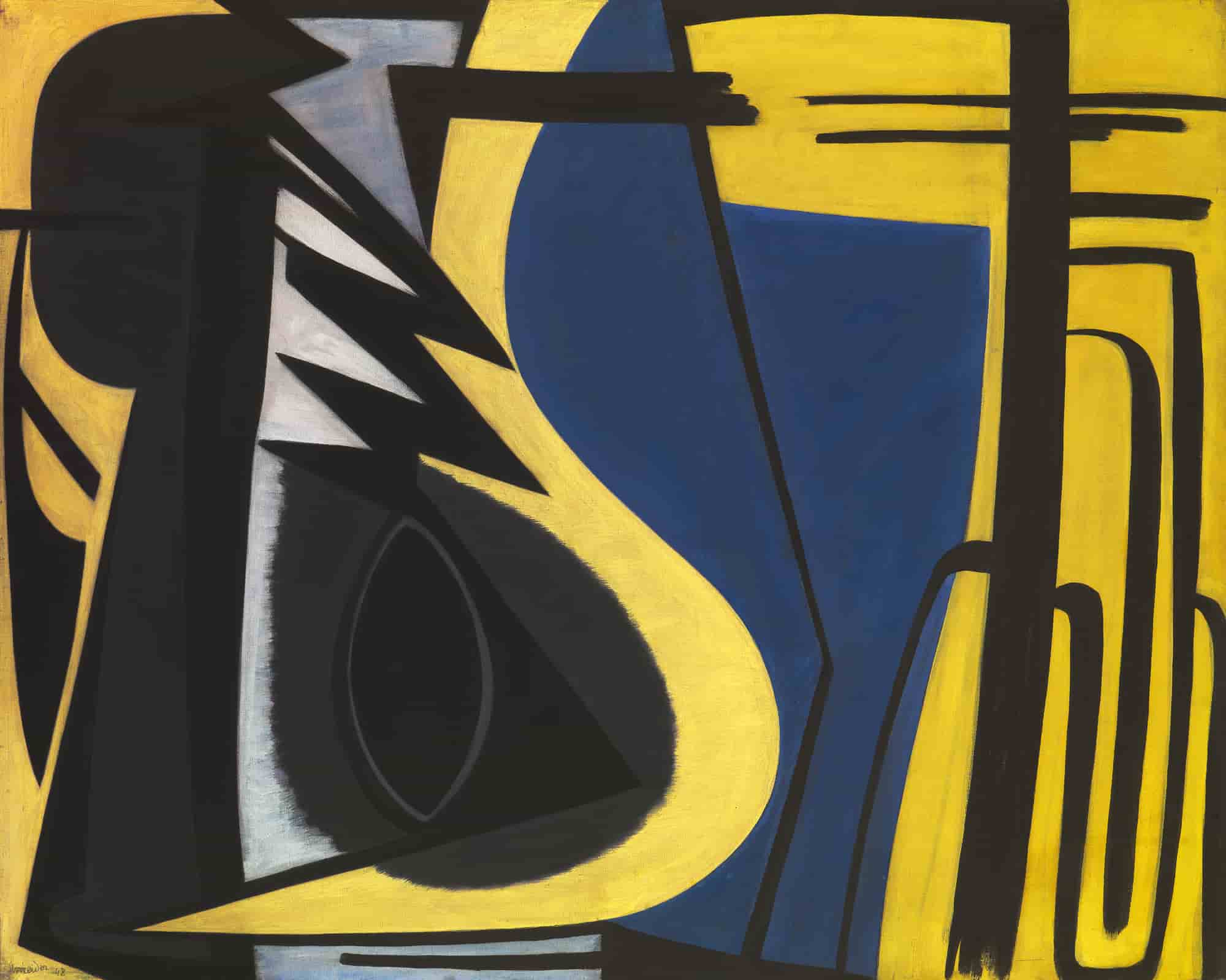
Opus 375, 1948
Oil on canvas
130 x 162 cm. / 51.18 x 63.78 in.
Signed & dated lower left
Private collection
Exposition
Gérard Schneider, L’abstraction lyrique comme ascèse, Galerie Artvera’s, Genève, Suisse, 22 nov. 2012 – 22 mai 2013
Publication
PERSIN Patrick-Gilles, Gérard Schneider, L’abstraction lyrique comme ascèse, catalogue d’exposition Galerie Artvera’s, Genève, Suisse, 2012 ; repr. coul. p.36

Portrait de Gérard Schneider devant Opus 375, rue Armand-Moisant, Paris, 1952. Photographie : Denise Colomb
© Archives Gérard Schneider.
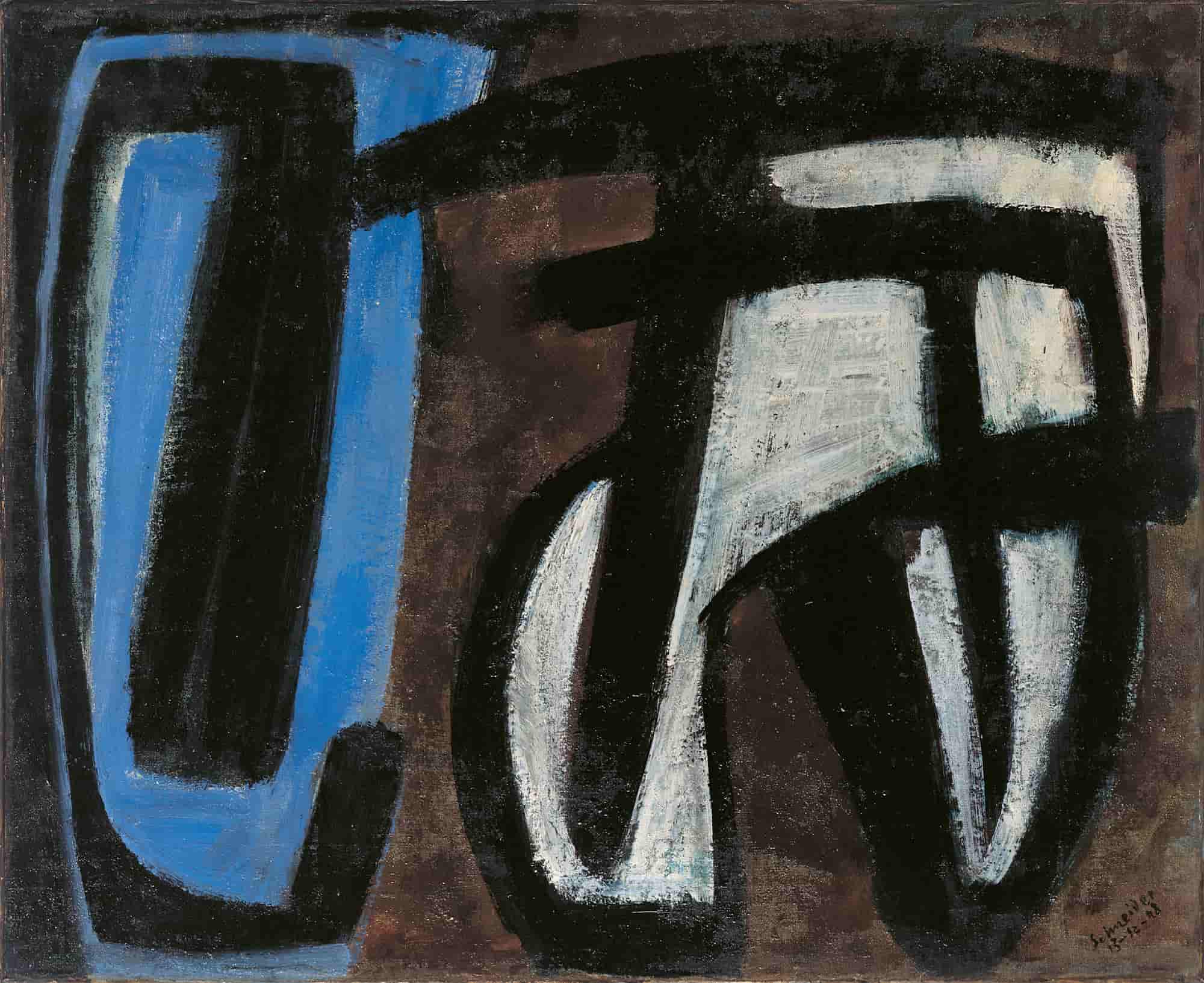
Opus 375-2, 1948
Oil on canvas
60 x 73 cm. / 23.62 x 28.74 in.
Signed & dated lower right
Private collection
Exhibitions
Galerie Lydia Conti, Paris, France, 1949
Gérard Schneider, Galleria civica d’Arte moderna, Turin, Italie,16 avril – 24 mai 1970
Publications
RAGON Michel, Schneider, Expressions contemporaines, Angers, France, 1998 ; repr. coul. p.72
IONESCO Eugène (Construction et devenir), MALLE Luigi (Unita e giovinezza di Schneider), MARCHIORI Giuseppe (Schneider Oggi), Gérard Schneider, catalogue d’exposition, Galleria civica d’Arte moderna, Turin, Italie, 1970 ; repr. n&b. p.75

Sans titre, 1949
Ink on paper
23,6 x 31,2 cm. (chaque)
9.29 x 12.28 in. (each)
Private collection


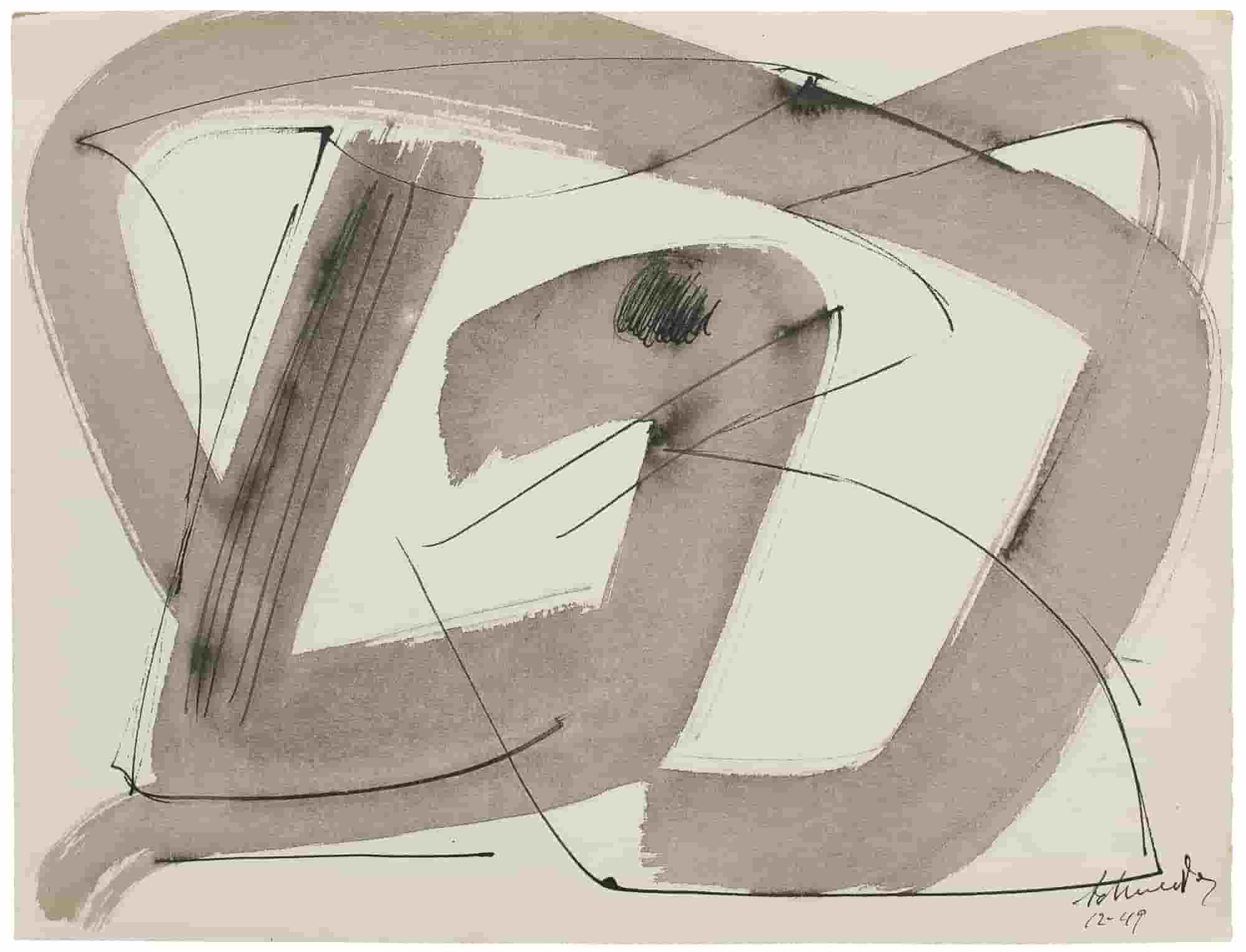

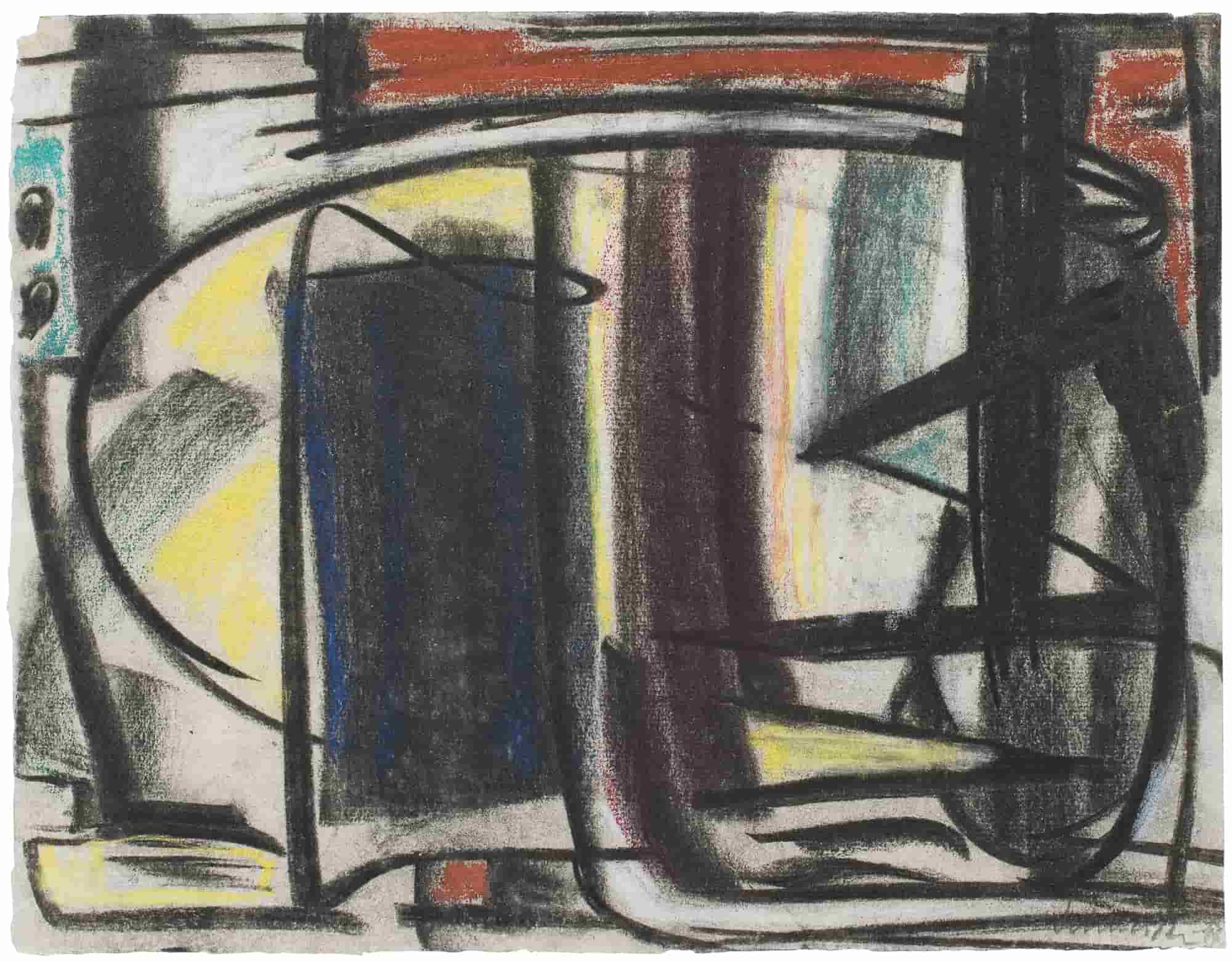
Sans titre, 1949
Charcoal & chalk on paper
24 x 30,7 cm. / 9.45 x 12.09 in.
Signed & dated lower right
Private collection
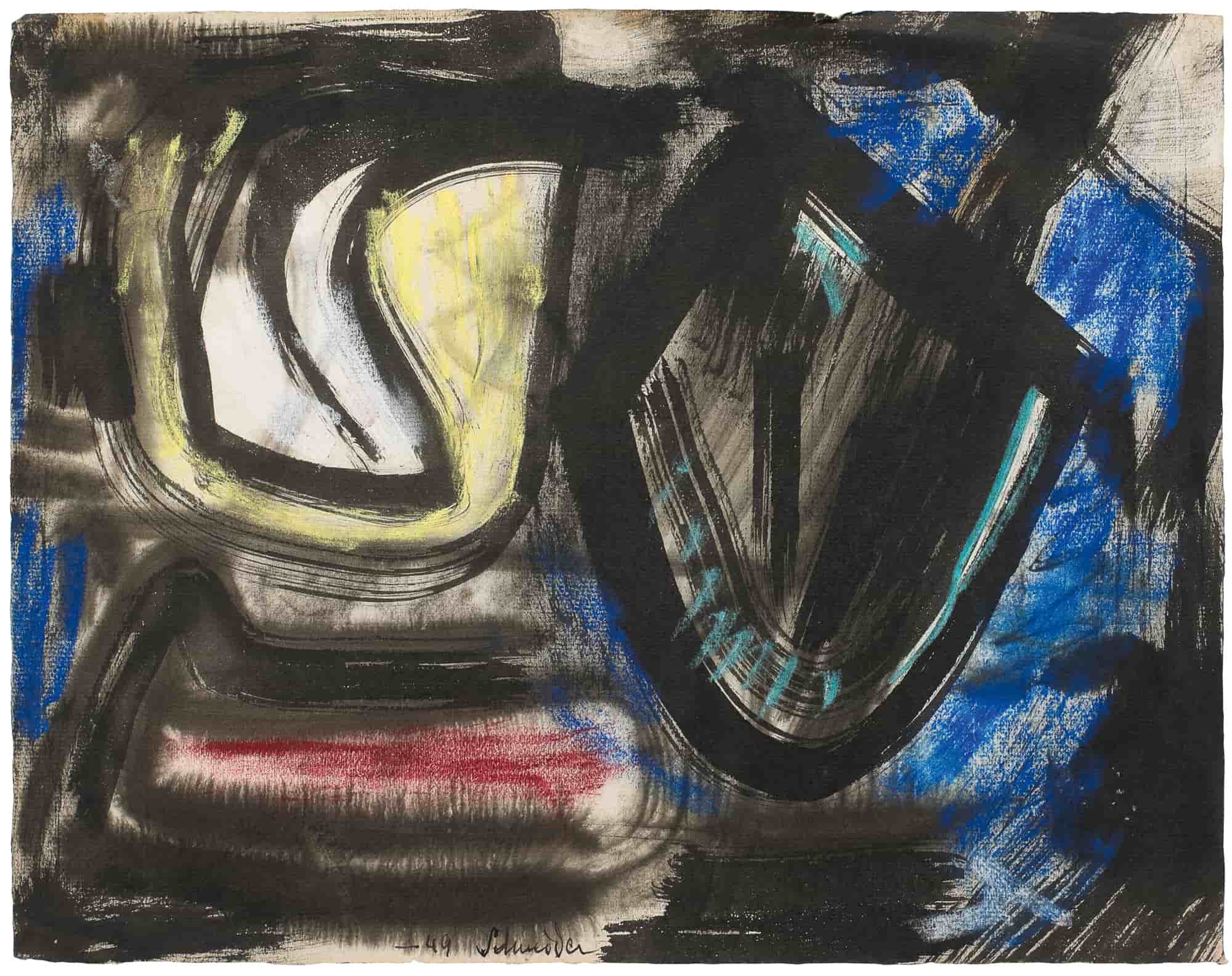
Sans titre, 1949
Charcoal, gouache & chalk on paper
23 x 30,8 cm. / 9.06 x 12.13 in.
Dated & signed in the lower middle
Private collection

Sans titre, 1949
Charcoal & chalk on paper
32 x 23,6 cm. / 12.6 x 9.29 in.
Private collection

Opus 428, 1949
Oil on canvas
60 x 73 cm. / 23.62 x 28.74 in.
Signed & dated lower right
Private collection
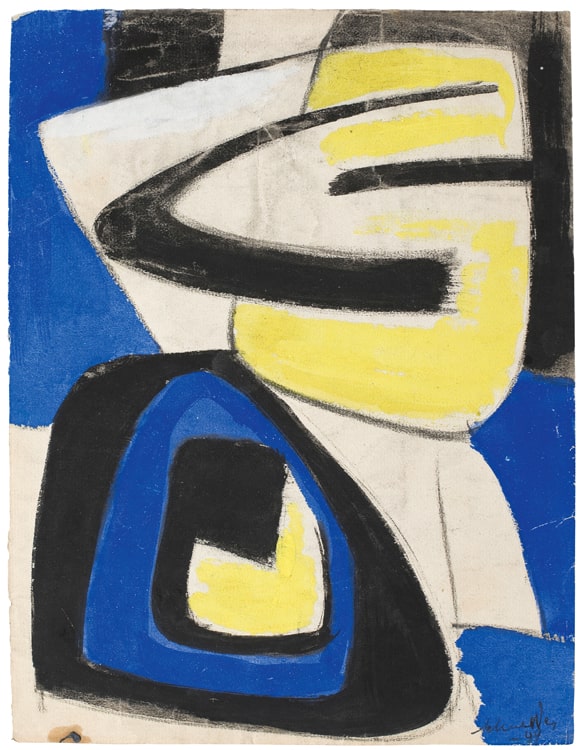
Sans titre, 1949
Gouache & chalk on paper
31,2 x 24 cm. (chaque) / 12.28 x 9.45 in. (each)
Private collection

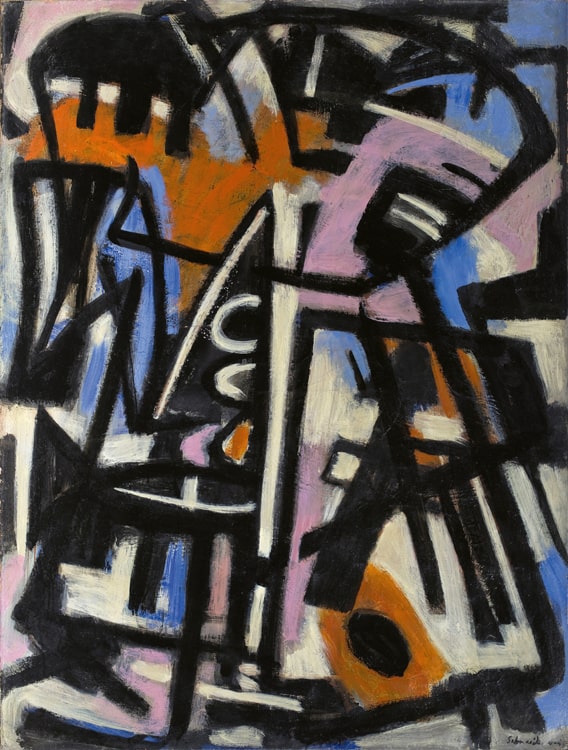
Opus 400, 1949
Oil on canvas
130 x 97 cm. / 51.18 x 38.19 in.
Signed & dated lower right
Private collection
Exhibitions
Advancing French Art, Galerie Louis Carré, New-York et dans les musées de Louisville, Baltimore, San Francisco, Bloomington, Chicago, Washington, D.C., États-Unis, 1951-1952, cat. n°8
Gérard Schneider, rétrospective, Kunstverein, Düsseldorf, Allemagne, 1962, cat. n°19
Gérard Schneider, rétrospective, Palais des Beaux-Arts, Bruxelles, Belgique, 1962, cat. n°19
Publications
BRION Marcel, Gérard Schneider, Kunstverein Düsseldorf, Allemagne, fascicule, mars-avril 1962 ; repr. n&b. n°19
BRION Marcel, Gérard Schneider, rétrospective, Palais des Beaux-Arts, Bruxelles, Belgique, juin 1962 ; repr. n&b. n°19
FRIGERIO Simone, Schneider, Quadrum, tiré à part ; repr. n&b. p.37

Opus 441, 1950
Oil on canvas
81 x 65 cm. / 31.89 x 25.59 in.
Signed & dated lower right
Private collection
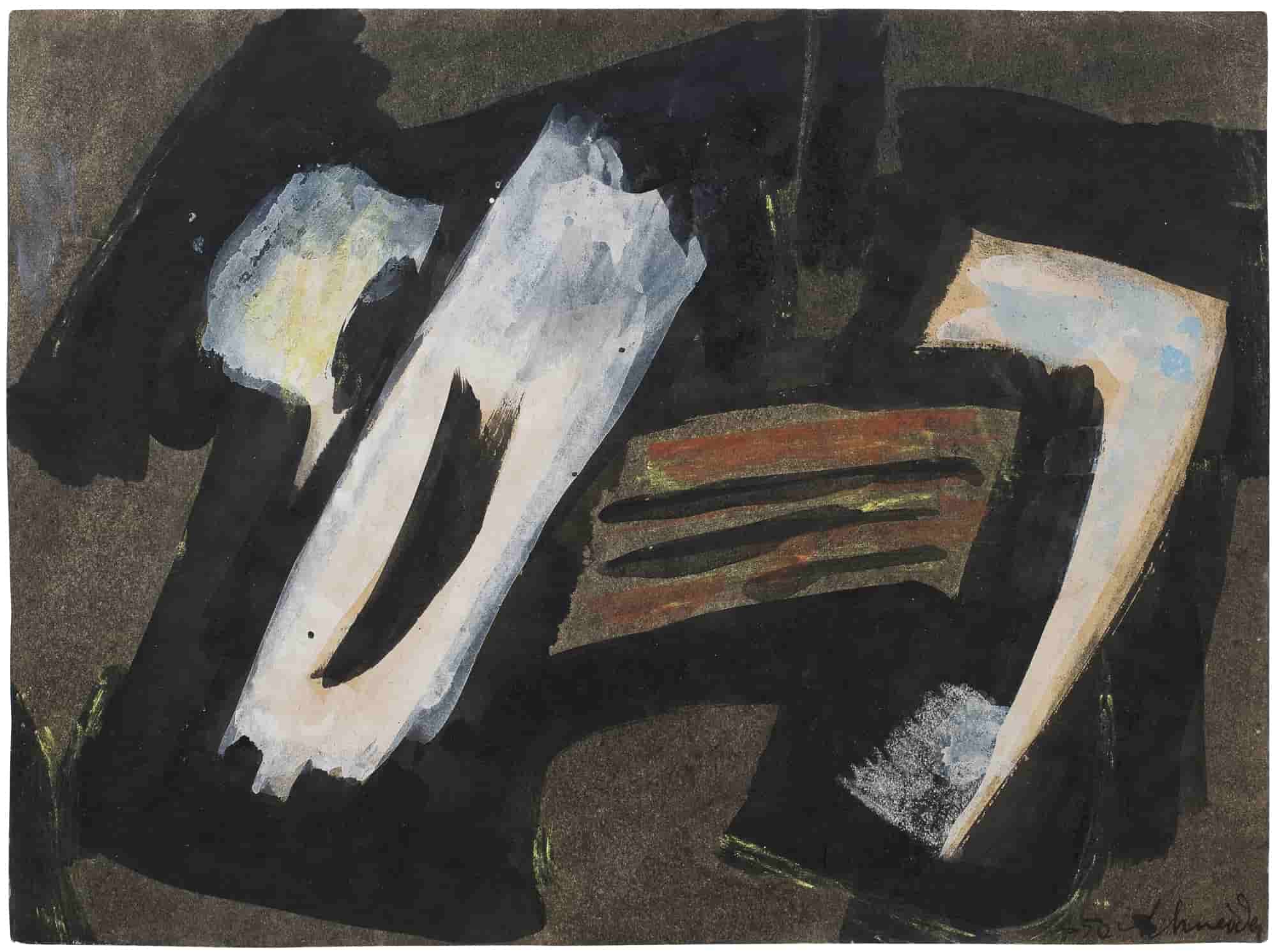
Sans titre, 1950
Gouache & chalk on paper
21,8 x 29,7 cm. / 8.58 x 11.7 in.
Dated & signed lower right
Private collection
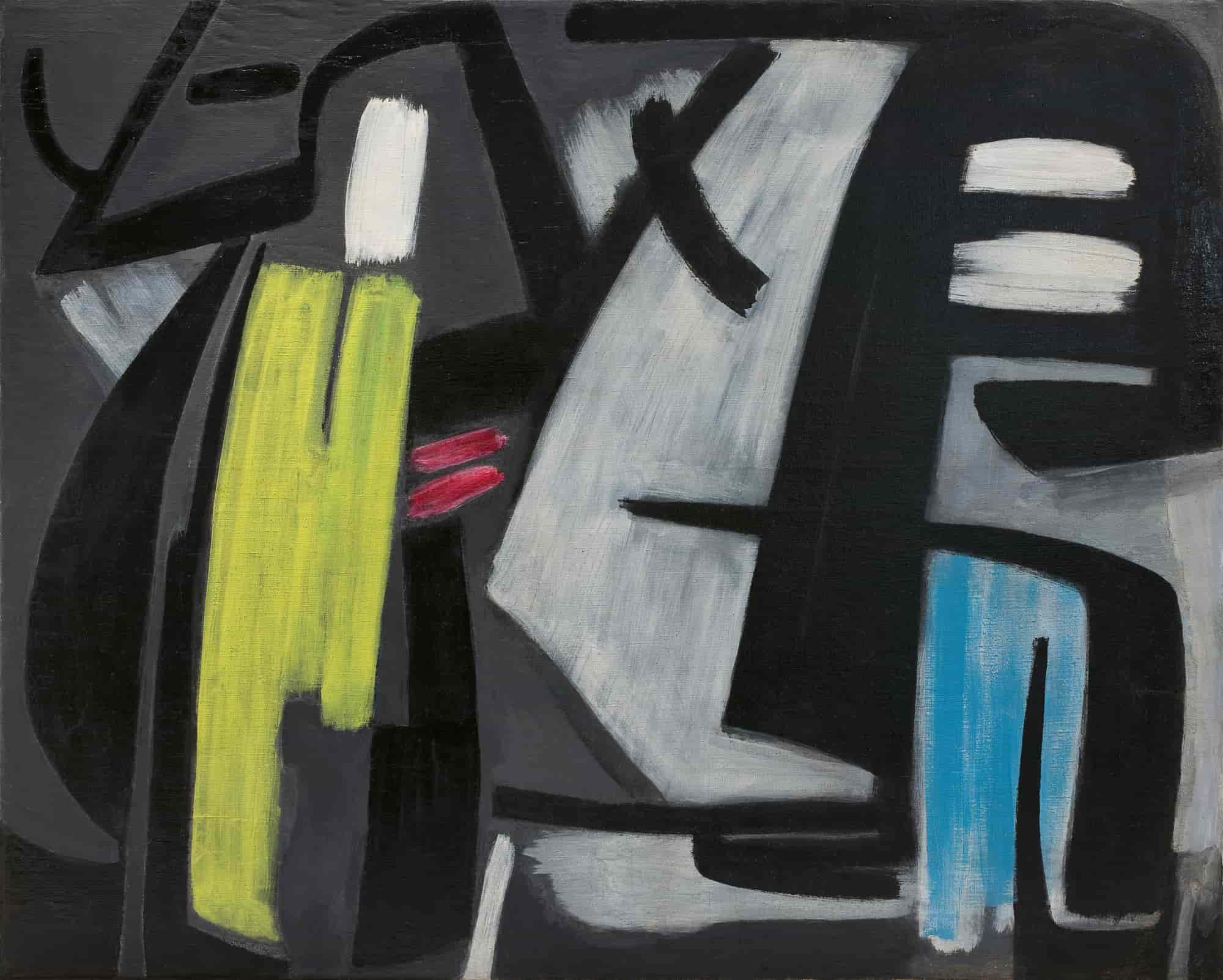
Opus 451, 1950
Oil on canvas
130 x 162 cm. / 51.18 x 63.78 in.
Signed & dated in the lower middle
Private collection
Expositions / Exhibitions
Hartung, Lanskoy, Schneider, Galerie Louis Carré, Paris, France, 1951
Advancing French Art, Galerie Louis Carré, New-York et dans les musées de Louisville, Baltimore, San Francisco, Bloomington, Chicago, Washington, D.C., États-Unis, 1951-1952
Gérard Schneider, rétrospective, Kunstverein, Düsseldorf, Allemagne, 1962, cat. n°21
Gérard Schneider, rétrospective, Palais des Beaux-Arts, Bruxelles, Belgique, 1962, cat. n°21
Schneider, Les années 50, Musée Pierre von Allmen, Thielle-Neuchâtel, Suisse, 1990
Publications
BRION Marcel, Gérard Schneider, Kunstverein, Düsseldorf, Allemagne, fascicule, mars-avril 1962 ; repr. n&b. n°21
BRION Marcel, Gérard Schneider, rétrospective, Palais des Beaux-Arts, Bruxelles, Belgique, juin 1962 ; repr. n&b. cat. n°21
BOUDAILLE Georges (Retour à Gérard Schneider) et Von VON Allmen Pierre (Rencontres), Schneider, Les années 50, catalogue d’exposition, Musée Pierre von Allmen, Thielle-Neuchâtel, Suisse, 1990 ; repr. n&b. n°9
FRIGERIO Simone, Schneider, Quadrum, tiré à part ; repr. n&b. p.40

Opus 488, 1951
Oil on canvas
55 x 46 cm. / 21.65 x 18.11 in.
Signed & dated in the lower middle
Private collection
Exhibition
Galerie Denise René, Paris, France, 1945

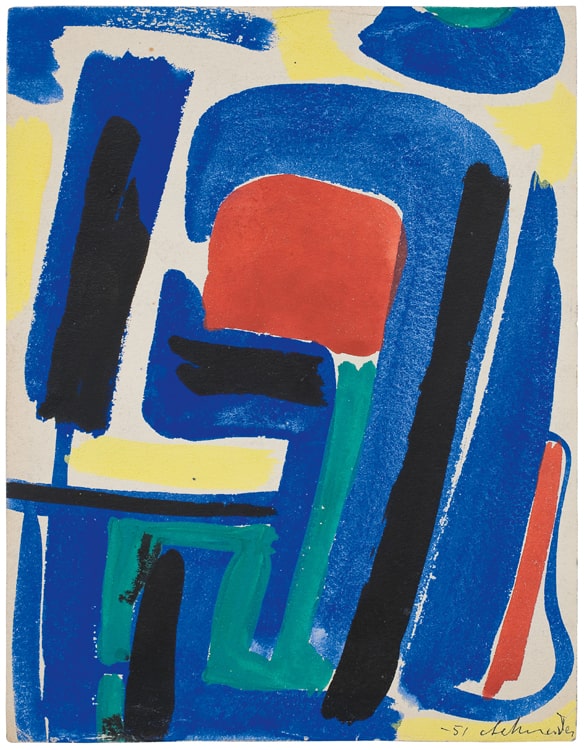
Sans titre, 1951
Gouache on paper
A – 21,8 x 17 cm. / 8.6 x 6.7 in.
B – 19 x 18,5 cm. / 7.48 x 7.28 in.
C – 18 x 21,7 cm. / 7.09 x 8.54 in.
D – 21,7 x 18 cm. / 8.54 x 7.09 in.
Private collection



Opus 494, 1952 ca .
Oil on canvas
72,5 x 92 cm. / 28.54 x 36.22 in.
Private collection
Exhibition
Gérard Schneider, L’abstraction lyrique comme ascèse, Galerie Artvera’s, Genève, Suisse, 22 nov. 2012 – 22 mai 2013
Publication
PERSIN Patrick-Gilles, Gérard Schneider, L’abstraction lyrique comme ascèse, catalogue d’exposition, Galerie Artvera’s, Genève, Suisse, 2012 ; repr. coul. p.41
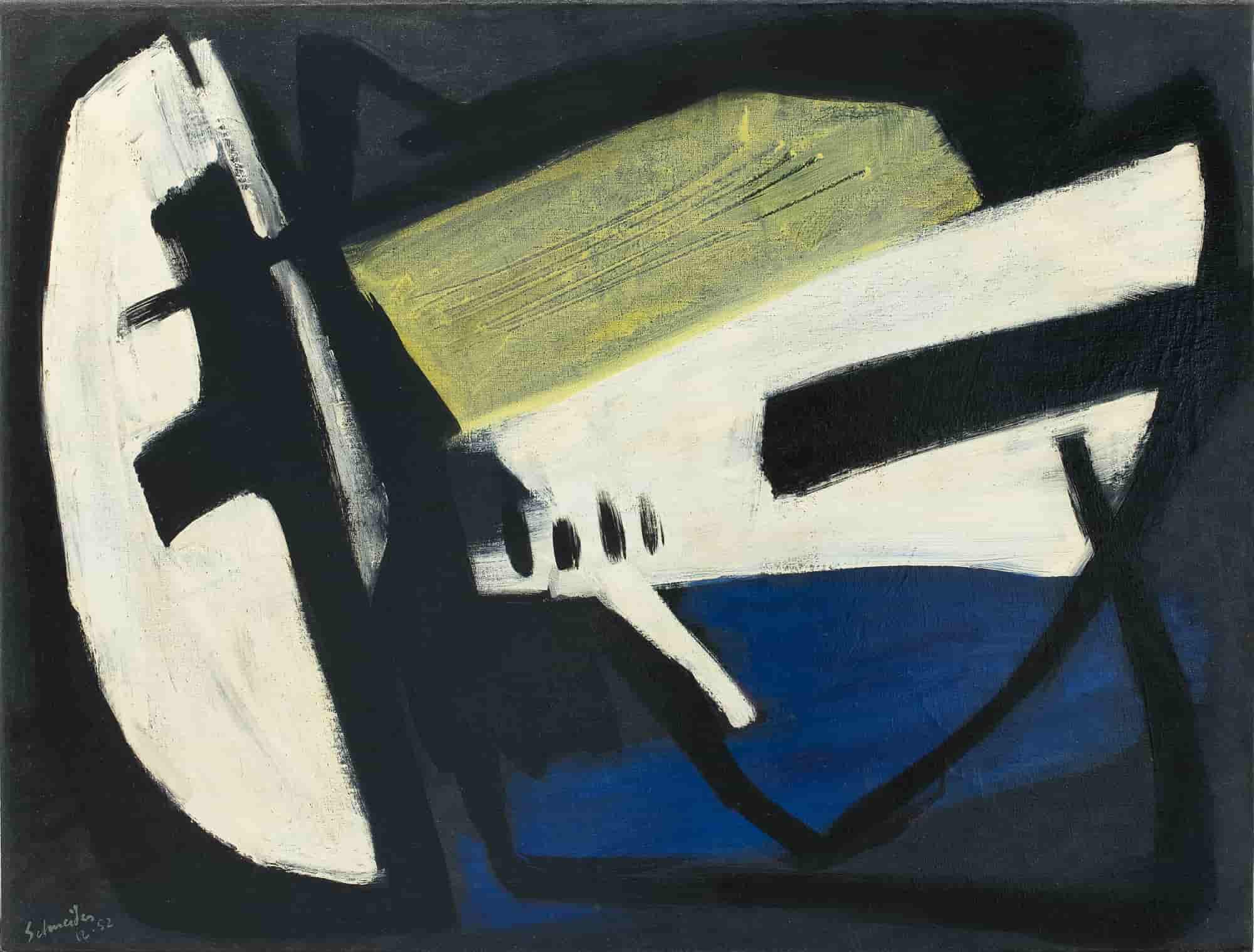
Opus 507, 1952
Oil on canvas
89 x 116 cm. / 35.04 x 45.67 in.
Signed & dated lower left
Private collection
Exhibitions
2ème Biennale de São Paulo, Museu de arte moderna de São Paulo, São Paulo, Brésil, 1953, cat. n°50
Galerie Galanis, Paris, France, 1954 École de Paris, Galerie Charpentier, Paris, France, 1954
Gérard Schneider, Kunstverein Düsseldorf, Allemagne, 20 mars – 23 avril 1962, cat. n°28
Gérard Schneider, Palais des Beaux-Arts, Bruxelles, Belgique, juin 1962, cat. n°28
Gérard Schneider, Galleria civica d’Arte moderna, Turin, Italie, 16 avril – 24 mai 1970
Publications
DUNOYER Jean-Marie, Schneider, Éditions Musée des Beaux-Arts de Neuchâtel, Neuchâtel, Suisse, 1983 ; repr. n&b. p.43
IONESCO Eugène (Construction et devenir), MALLE Luigi (Unita e giovinezza di Schneider), MARCHIORI Giuseppe (Schneider Oggi), Gérard Schneider, catalogue d’exposition, Galleria civica d’Arte moderna, Turin, Italie, 1970 ; repr. n&b.
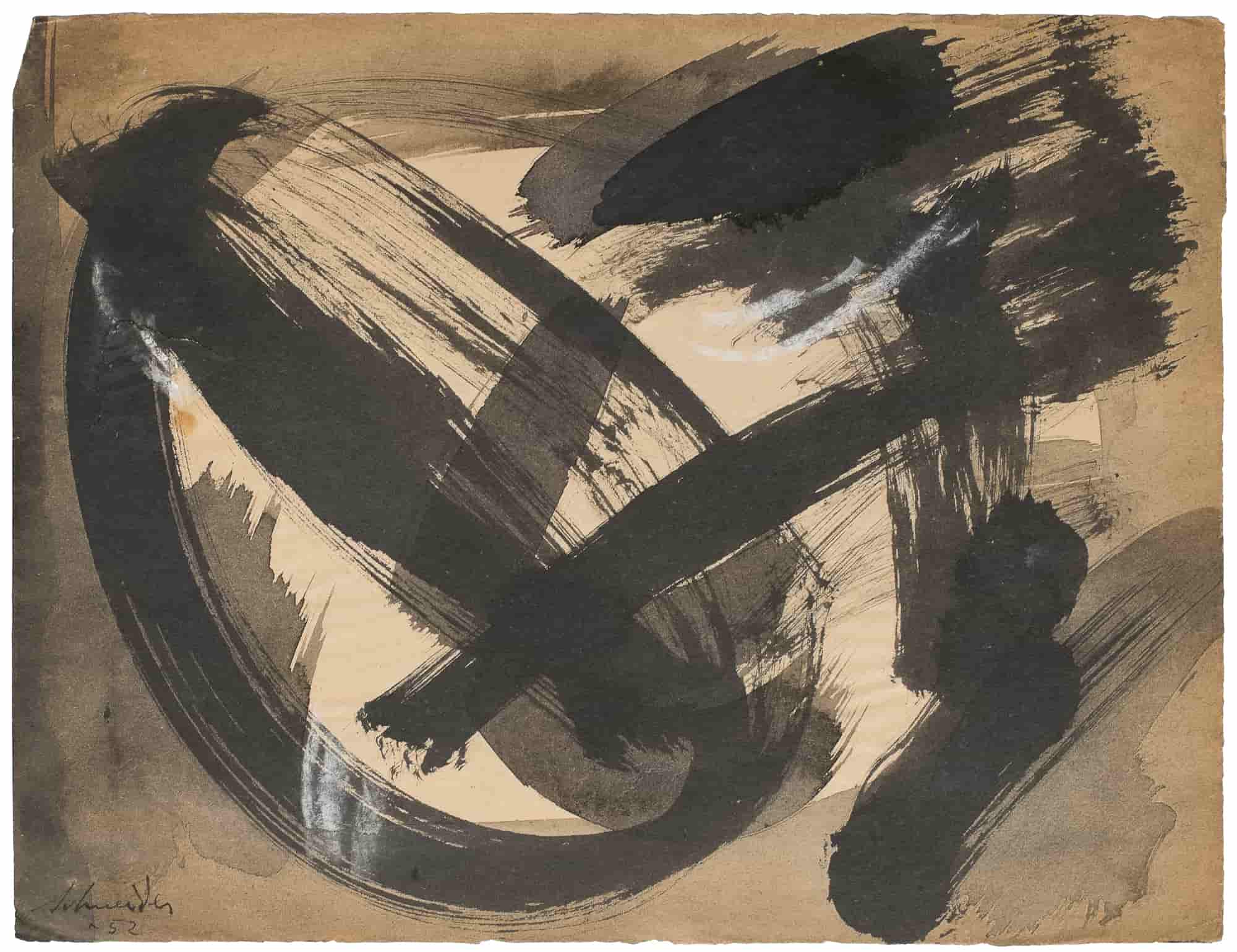
Sans titre, 1952
Ink on paper
24,6 x 32,5 cm. / 9.7 x 12.8 in.
Signed & dated lower left
Private collection

Opus 29B, 1953
Oil on canvas
114 x 146 cm. / 44.88 x 57.48 in.
Signed & dated lower right
Private collection
Exposition / Exhibition
École de Paris, Galerie Charpentier, Paris, France, 1956
Publication
BOKUBI n°37 [Revue], Kyoto, Japon, 1954 ; repr. n&b. p.7
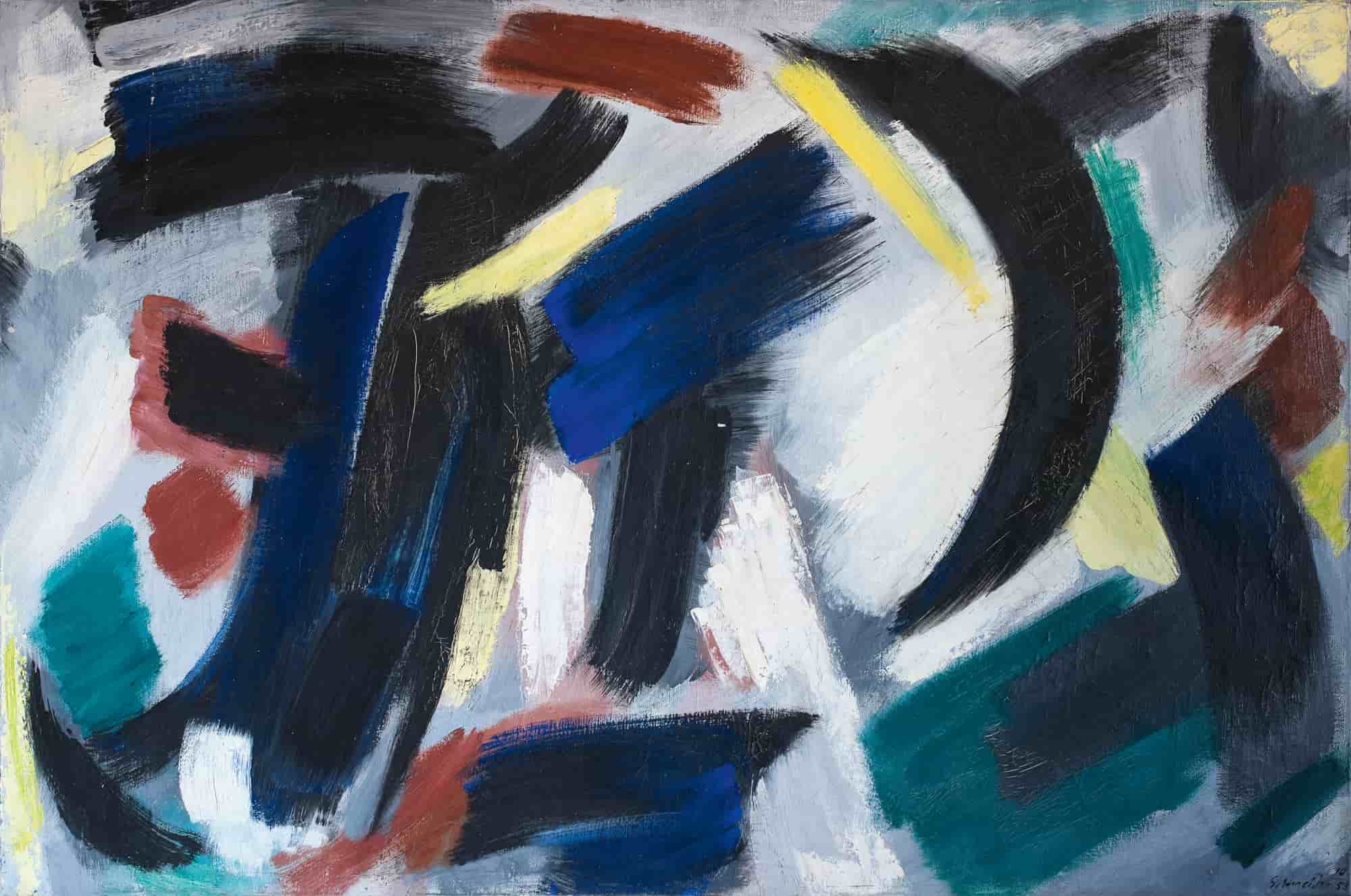
Opus 443, 1953
Oil on canvas
96,5 x 145,5 cm. / 38 x 57.28 in.
Signed & dated lower right
Private collection
Publication
XURIGUERA Gérard, Schneider, La flamboyance du geste, Cimal. 6, Gandia, Espagne, 1985 ; repr. n&b. p.30

Opus 47B, 1953
Oil on canvas
130 x 97 cm. / 51.18 x 38.19 in.
Signed lower left
Private collection
Exhibition
Gérard Schneider, Galerie Diane de Polignac, Paris, France, 2014
Publication
DE CHAZOURNES Khalil & DE POLIGNAC Diane, SCHNEIDER Laurence, CHABRISSOUX Daniel & SCHNEIDER Loïs, Gérard Schneider, catalogue d’exposition, Galerie Diane de Polignac, Paris, France, 2014 ; repr. coul. p.29
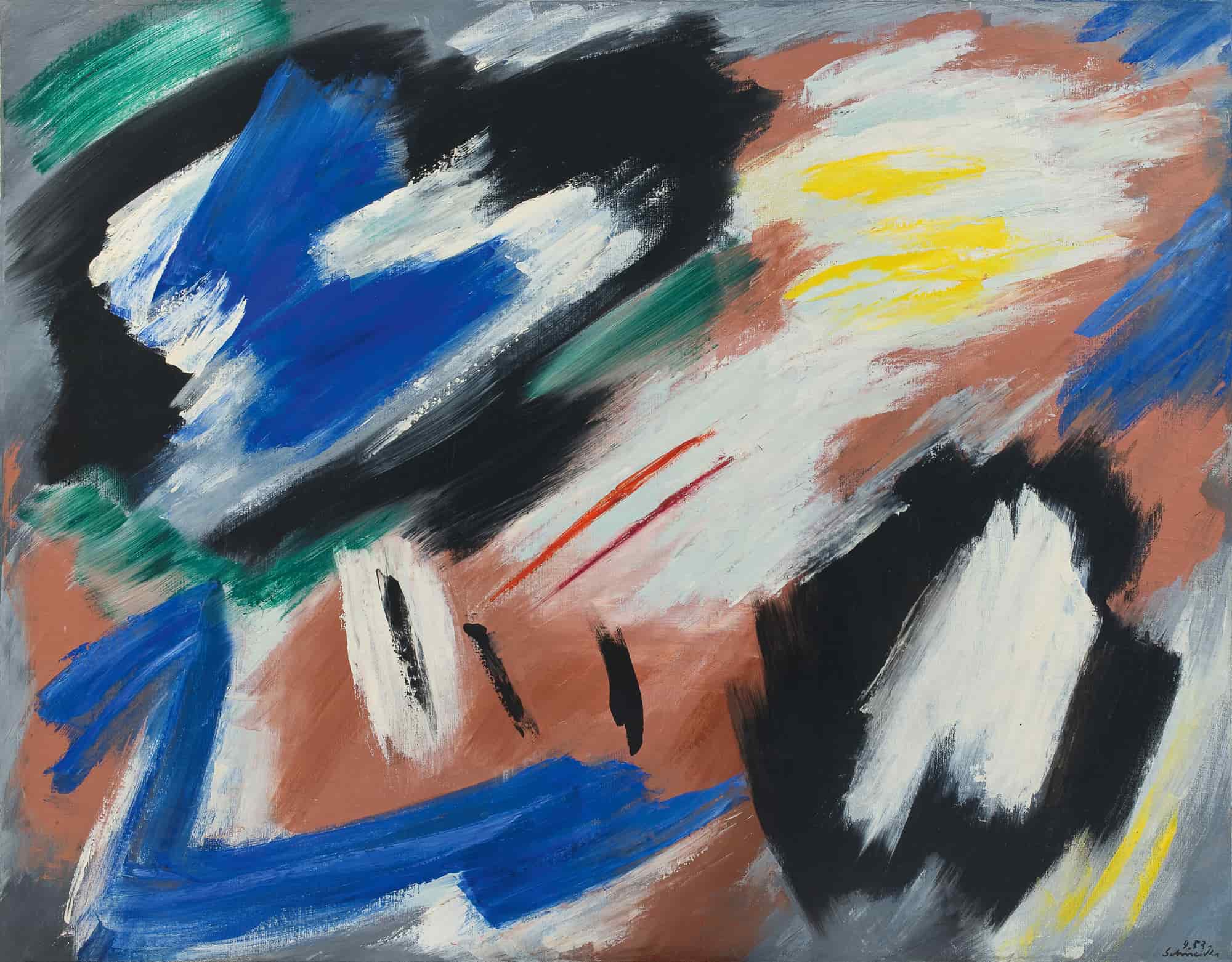
Opus 50 B, 1953
Oil on canvas
114 x 146 cm. / 44.88 x 57.48 in.
Signed & dated lower right
Private collection
Publications
ORIZET Jean, Schneider, L’Autre Musée/ La différence, Paris, France, 1984 ; repr. n&b. p.37
XURIGUERA Gérard, Schneider, La flamboyance du geste, Cimal. 6, Gandia, Espagne, 1985 ; repr. n&b. p.31
BOKUBI n°37 [Revue], Kyoto, Japon, 1954 ; repr. n&b. couv. et dernière de couv.
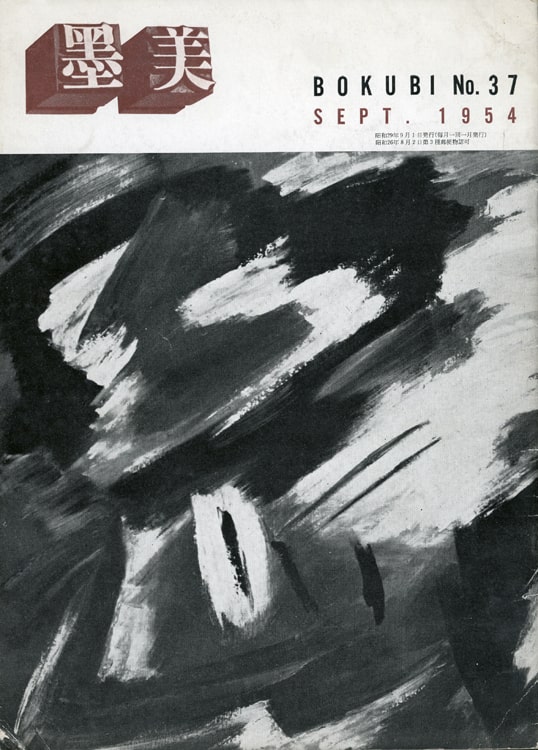
Cover of the Bokubi magazine, Japan, 1954.

Opus 23 B, 1953
Oil on canvas
97 x 146 cm. / 38.19 x 57.48 in.
Signed & dated lower right
Private collection
Exhibition
Schneider, Palais des Beaux-Arts, Bruxelles, Belgique, 1953
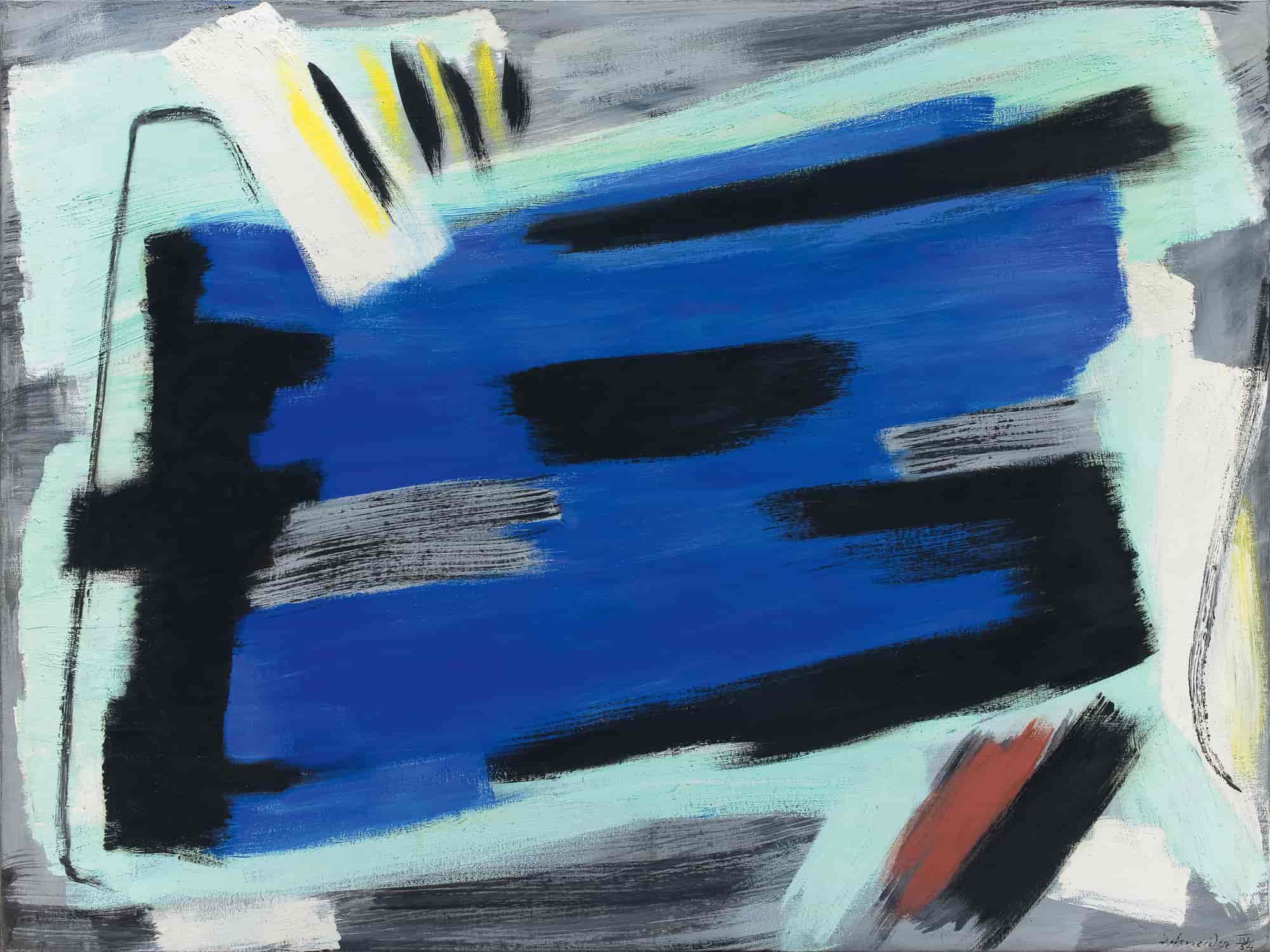
Opus 63 B, 1954
Oil on canvas
150 x 200 cm. / 59.06 x 78.74 in.
Signed & dated lower right
Private collection

Sans titre, 1954
Inks on paper
20,2 x 27,2 cm. / 7.95 x 10.71 in.
Signed & dated lower right
Private collection

Sans titre, 1954
Inks on paper
21 x 26,9 cm. / 8.27 x 10.6 in.
Signed & dated lower right
Private collection

Sans titre, 1954
Inks & pastel on paper
20,9 x 26,9 cm. / 8.23 x 10.6 in.
Signed & dated lower right
Private collection

Sans titre, 1954
Inks on paper
21 x 26,9 cm. / 8.27 x 10.6 in.
Signed & dated lower right
Private collection

Gérard Schneider posant devant Opus 65 B, rue Armand-Moisant, Paris, 1954 ca. – Photographie : Margo Friters- Drucker – © Archives Gérard Schneider.
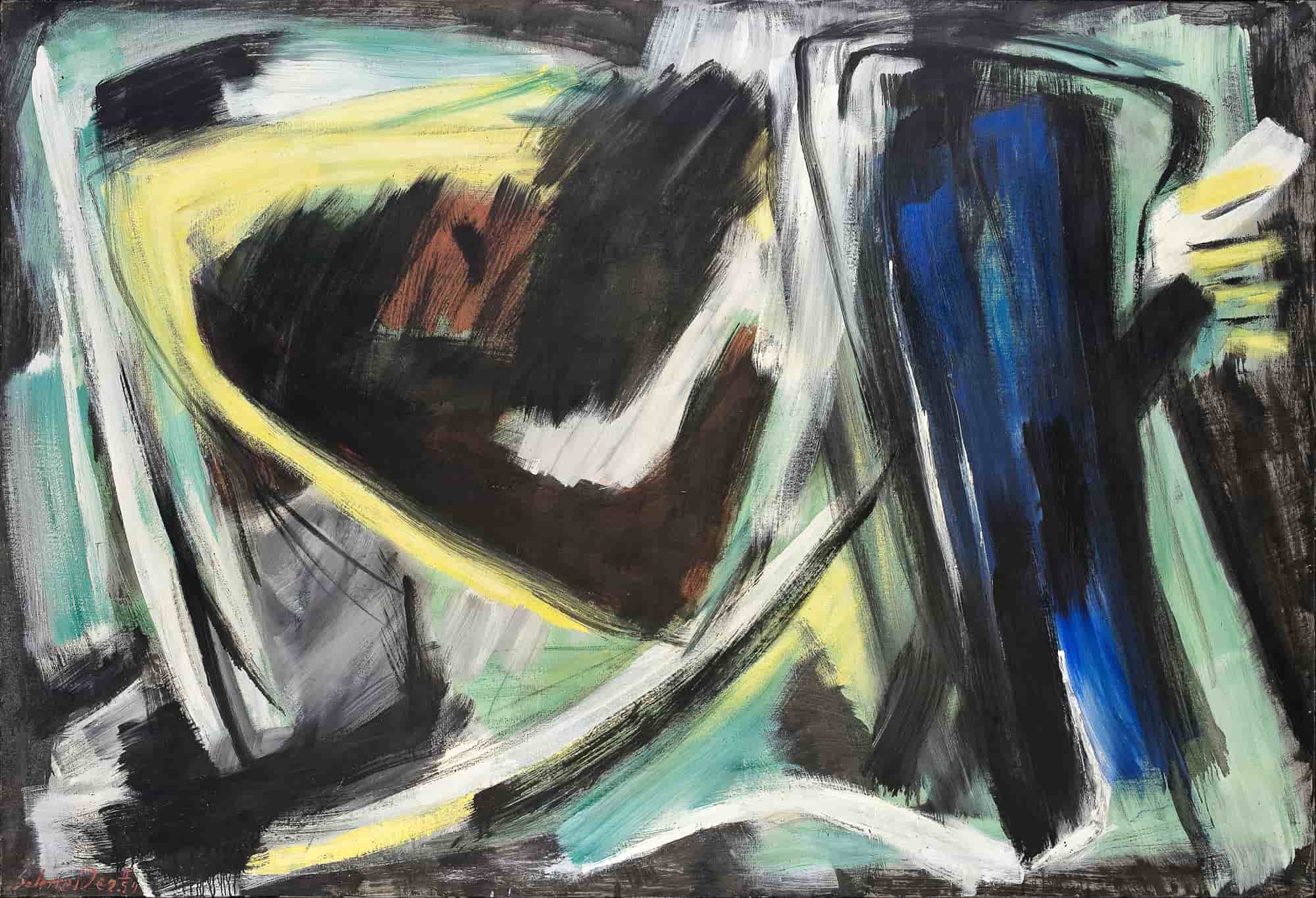
Opus 65 B, 1954
Oil on canvas
150 x 220 cm. / 59.06 x 86.61 in.
Signed & dated lower left
Private collection
Exhibitions
6ème Biennale de São Paulo, Museu de arte moderna de São Paulo, São Paulo, Brésil, 1961, cat. n°51
Gérard Schneider, Kunstverein Düsseldorf, Allemagne, 20 mars – 23 avril 1962, cat. n°34
Gérard Schneider, Palais des Beaux-Arts, Bruxelles, Belgique, juin 1962, cat. n°34
Gérard Schneider, Galleria civica d’Arte moderna, Turin, Italie, 16 avril – 25 mai 1970
Schneider, rétrospective, Musée d’Art contemporain, Dunkerque, France, 1983
Hommage à Gérard Schneider, Maison des Princes, Pérouges, France, 1988
Schneider, Les années 50, Musée Pierre von Allmen, Thielle-Neuchâtel, Suisse, 1990
Schneider, Los años 50, Fundacion BBK Fundazioa, Bilbao, Espagne, 25 janvier – 17 avril 2006
Gérard Schneider, une rétrospective, Musée des beaux-arts, Orléans, France, 2013
Publications
BRION Marcel et GINDERTAËL R.V., Schneider, Alfieri, Venise, Italie, 1967 ; repr. coul. pl. n°15
DUNOYER Jean-Marie, Schneider, Editions Musée des Beaux-Arts de Neuchâtel, Neuchâtel, Suisse 1983 ; repr. coul. p.33
ORIZET Jean, Schneider, L’Autre Musée/ La différence, Paris, France, 1984 ; repr. coul. couv.
POBÉ Marcel, Schneider, G. Fall, coll. Le Musée de Poche, Paris, France, 1959 ; repr. coul. p.17
RAGON Michel, Schneider, Expressions contemporaines, Angers, France, 1998 ; repr. coul. p.99
BRION Marcel, Gérard Schneider, Kunstverein Düsseldorf, Allemagne, fascicule, mars-avril 1962 ; repr. n&b. catalogue n°34
BRION Marcel, Gérard Schneider, rétrospective, Palais des Beaux-Arts, Bruxelles, Belgique, juin 1962 ; repr. n&b. catalogue n°34
BOUDAILLE Georges (Retour à Gérard Schneider) et Von Allmen Pierre (Rencontres), Schneider, Les années 50, catalogue d’exposition, Musée Pierre von Allmen, Thielle-Neuchâtel, Suisse, 1990 ; repr. coul. p.41
CHABRISSOUX Daniel et FREDERICK Loïs, (Entretien avec Loïs Frederick), catalogue de l’exposition Gérard Schneider, oeuvres de 1916 à 1986, Expressions contemporaines, Angers, France, 1991 ; repr. coul. pp.26-27
CHABRISSOUX Daniel & FREDEREICK Loïs, RAGON Michel, Schneider, Los años 50, catalogue d’exposition, Fundacion BBK Fundazioa, Edition Fundacion Bilbao Bizkaia Kutxa Fundazioa, Bilbao, Espagne, 2006 ; repr. coul. p.129
FAUCHER Michel, Schneider, catalogue d’exposition, Musée d’Art contemporain de Dunkerque, France, juin-sept. 1983 ; repr. coul.
IONESCO Eugène (Construction et devenir), MALLE Luigi (Unita e giovinezza di Schneider), MARCHIORI Giuseppe (Schneider Oggi), Gérard Schneider, catalogue d’exposition, Galleria civica d’Arte moderna, Turin, Italie, 1970 ; repr. n&b.
FRIGERIO Simone, Schneider, Quadrum, tiré à part ; repr. coul.
DIEHL Gaston, La peinture moderne dans le monde, Flammarion, Paris, France, 1966 ; repr. coul. p.171

Sans titre, 1947
Oil on paper
24 x 31,3 cm. / 9.45 x 12.32 in.
Signed & dated lower left
Private collection

Opus 89 B, 1955
Oil on canvas
81 x 100 cm. / 31.89 x 39.37 in.
Signed & dated lower right
Private collection
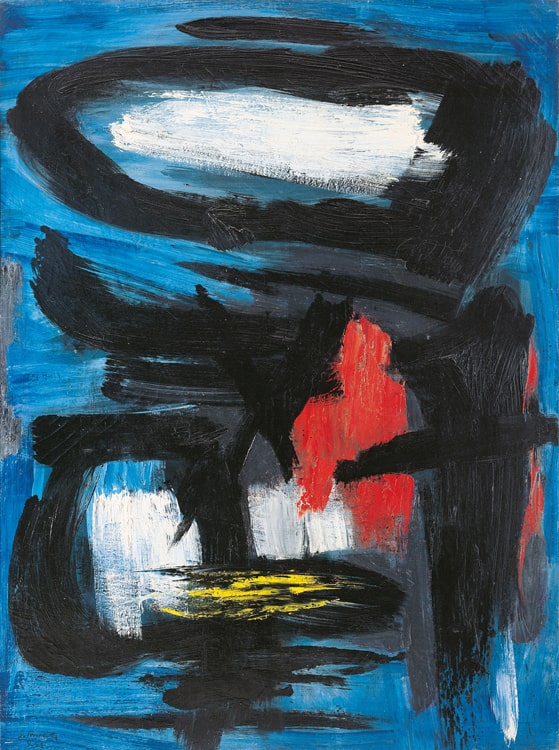
Opus 87 B, 1955
Oil on canvas
130 x 97 cm. / 51.18 x 38.19 in.
Signed & dated lower left
Private collection
Exhibitions
Schneider, Los años 50, Fundacion BBK Fundazioa, Bilbao, Espagne, 25 janvier – 17 avril 2006
Gérard Schneider, grands gestes pour un grand monde, Musée d’Art & d’Histoire, Neuchâtel, Suisse, 2011
Gérard Schneider, une rétrospective, Musée des beaux-arts, Orléans, France, 2013
Publications
DUNOYER Jean-Marie, Schneider, Editions Musée des Beaux-Arts de Neuchâtel, Neuchâtel, Suisse, 1983 ; repr. n&b. p.51
ORIZET Jean, Schneider, L’Autre Musée/ La différence, Paris, France, 1984 ; repr. coul. p.38
RAGON Michel, Schneider, Expressions contemporaines, Angers, France, 1998 ; repr. coul. p.104
BOUDAILLE Georges (Retour à Gérard Schneider) et Von Allmen Pierre (Rencontres), Schneider, Les années 50, catalogue d’exposition, Musée Pierre von Allmen, Thielle-Neuchâtel, Suisse, 1990 ; repr. coul. p.45
Brion Marcel, Art abstrait, Albin Michel, Paris, France,1956, repr. coul. couv.

Marcel Brion, Art abstrait, Albin Michel, Paris, 1956
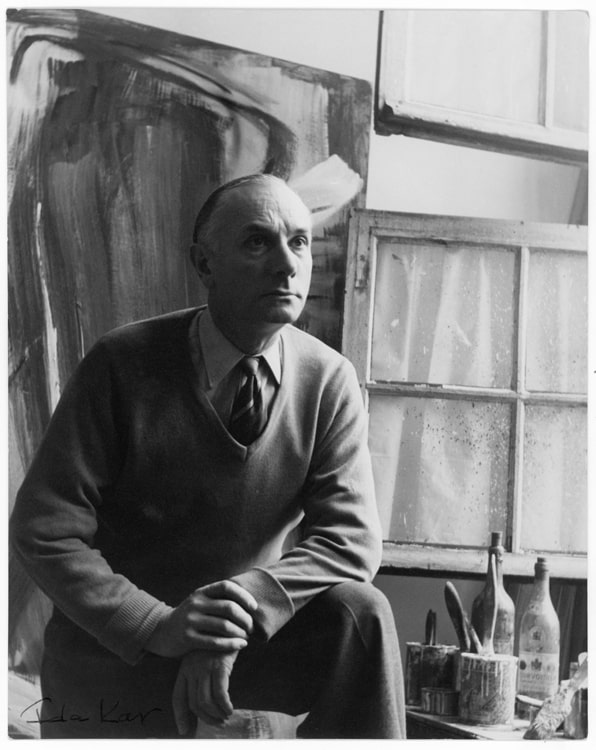
PRINCIPALES EXPOSITIONS PERSONNELLES
1920 Galerie Léopold Robert, Neuchâtel, Suisse
1947 Galerie Lydia Conti, Paris, France
1948 Galerie Lydia Conti, Paris, France
1950 Galerie Lydia Conti, Paris, France
1951 Galerie de Beaune, Paris, France
1952 Galerie Ex-Libris, Bruxelles, Belgique
Galerie Der Spiegel, Cologne, Allemagne
Kaiser Wilhelm Museum, Krefeld, Allemagne
Galerie Otto Stzangl, Munich, Allemagne
1953 Palais des Beaux-Arts, Bruxelles, Belgique
Galerie Der Spiegel, Cologne, Allemagne
1954 Galerie Galanis, Paris, France
1956 Kootz Gallery, New York, États-Unis
1957 Kootz Gallery, New York, États-Unis
Galerie Der Spiegel, Cologne, Allemagne
Exposition organisée par l’éditeur Marcel Joray, Neuchâtel, Suisse
1958 Kootz Gallery, New York, États-Unis
Galleria Apollinaire, Milan, Italie
1959 Kootz Gallery, New York, États-Unis
Galerie du Musée de Poche, Paris, France
1960 Minami Gallery, Tokyo, Japon
Nakanoshima Gallery, Osaka, Japon
1961 Kootz Gallery, New York, États-Unis
Galleria Lorenzelli, Milan, Italie
Galerie lrn Erker, Saint-Gall, Suisse
Galerie Arditti, Paris, France
1962 Rétrospective, Kunstverein, Düsseldorf, Allemagne
Rétrospective, Palais des Beaux-Arts, Bruxelles, Belgique
1964 Galleria Il Centro, Naples, Italie
Galleria Il Cancello, Bologne, Italie
Galerie Argos, Nantes, France
1965 Musée des Beaux-Arts, Verviers, France
Galleria Lorenzelli, Bergame, Italie
Galleria Flaviana, Locarno, Suisse
Galerie Arnaud, Paris, France
1966 Biennale de Venise, Italie
1967 Galerie Arnaud, Paris, France
Institut français, Barcelone, Espagne
1968 Galleria San Fedele, Milan, Italie
Centro Culturale Antonino Rosmini, Trente, Italie
Institut français, Rabat, Maroc
Galleria Documenta-Martano, Turin, Italie
Galerie Arnaud, Paris, France
1970 Rétrospective, Galleria civica d’Arte moderna, Turin, Italie
Rétrospective, Pavillon Terre des Hommes, Montréal, Canada
Salle des expositions municipales, Vitry-sur-Seine, France
Galerie Cavalero, Cannes, France
Galerie Gilles Corbeil, Montréal, Canada
Galerie Arnaud, Paris, France
Galleria Falchi, Milan, Italie
1971 Galleria La Nuova Loggia, Bologne, Italie
1972 Galerie Protée, Toulouse, France
Galleria Lorenzelli, Bergame, Italie
Galerie Cazenave, Paris, France
Galerie Cavalero, Cannes, France
1973 Galerie Paul Brück, Luxembourg
Galleria R. Rotta, Gênes, Italie
1974 Galleria Lorenzelli, Milan, Italie
Galerie Cavalero, Cannes, France
Galerie Protée, Toulouse, France
1974-1975 Instituts français, capitales d’Amérique latine Maisons des jeunes et de la culture de Belleville Paris
– Thonon-les-Bains – Toulouse, France
1975 Galerie Beaubourg, Paris, France
Galerie Albert Verbeke, Paris, France
Art Club Frédéric Gollong, Saint-Paul-de-Vence, France
1976 Festival des arts, Reykjavik, Islande
Institut Français, Oslo, Norvège
Galerie d’Orsay, Cannes, France
Galerie le Dessin, Paris, France
1977 Galerie Beaubourg, Paris, France
1978 Galerie Lucas, Paris, France
Kunstmesse, Cologne, Suisse
Galerie Flaviana, Basel, Suisse
Centre culturel, Ris-Orangis, France
1979 Galeria Kandinsky, Madrid, Espagne
1982 Galerie Art 62, Cannes, France
1983 Rétrospective, Musée d’Art et d’Histoire, Neuchâtel, Suisse
Rétrospective, Musée d’Art contemporain, Dunkerque, France
Rétrospective, Foire International d’Art Contemporain (FIAC), Galerie Patrice Trigano, Paris, France
1984 Galerie Jacqueline Storm, Lille, France
1985 Galerie Léa Gredt, Luxembourg, France
Salle des expositions municipales, Nancy, France
Kunstmesse, Galerie Pierre Huber, Bâle, Suisse
Galerie Sapone, Nice, France
1986 Galerie Ditesheim, Neuchâtel, Suisse
Galerie Hélène Trintignant, Montpellier, France
Galerie am Züriberg, Zurich, Suisse
Galerie Patrice Trigano, Paris, France
Galleria Saint-André, Savone, Italie
Château de Pondres, festival de Montpellier, France
“Hommage à Gérard Schneider” (Homage to Gérard Schneider) PACA, Angers – Cholet – Saumur, France
Galerie Pierre Huber, Bâle, Suisse
1987 Galerie Heyram, Paris, France
Galleria Lorenzelli, Milan, Italie
1988 Maison des Princes, Pérouges, France
Galerie Heyram, Paris, France
Galerie Royal Fine Arts, Genève, Suisse
Galerie Léa Gredt, Luxembourg
Galerie MT Müller, Auvernier, France
Centre d’Art contemporain, Évry, France
1989 Galerie Heyram, Paris, France
Galleria Lorenzelli, Milan, Italie
1990 Galerie Proarta, Zurich, Suisse
Musée Pierre von Allmen, Thielle-Wavre (Neuchâtel), Suisse
Galerie Heyram, Paris, France
Galerie Prazan-Fitoussi, Paris, France
1991 Scène Nationale, Cherbourg, France
Espace Athanor, Guérande, France
1992 Palais des Festivals, Biarritz, France
Musée Hébert, Grenoble, France
Château d’Ambroise, France
1993 Espace Saint Jean, Melun, France
Maison de la Culture, Nevers, France
1998-2000 Rétrospective itinérante en France : Musée de Quimperlé – Musée des Beaux-Arts de Carcassonne
– Maison de la Culture de Bourges – Musée du Mans – Musée de la Cour d’Or, Metz – Musée du Château de Montbéliard, France
2006 One Man show, Galerie Applicat-Prazan, FIAC, Grand Palais, Paris, France
2011 “Gérard Schneider, grands gestes pour un grand monde” (Gérard Schneider, large gestures for a big world), Musée d’Art et d’Histoire, Neuchâtel, Suisse
2012 “Gérard Schneider, l’abstraction lyrique comme ascèse”
(Gérard Schneider, Lyrical abstraction as asceticism), Galerie Artvera’s, Genève, Suisse
2013 “Gérard Schneider”, rétrospective, musée des Beaux-Arts d’Orléans, Paris
2014 “Gérard Schneider”, Galerie Diane de Polignac, Paris
2017 “Gérard Schneider, 1945-1955 De l’Abstraction au Lyrisme” (Gérard Schneider, 1945-1955 From Abstraction to Lyricism) Galerie Diane de Polignac & Chazournes, Paris
PRINCIPALES EXPOSITIONS COLLECTIVES
1926 Salon d’Automne, Paris
1936 Salon des Surindépendants, Paris, France
1937 Salon des Surindépendants, Paris, France
1938 Salon des Surindépendants, Paris, France
1945 Salon des Surindépendants, Paris, France
Première exposition d’art abstrait d’art abstrait d’Après-guerre, local de la rue Cujas, Paris, France
1946 “Peintures abstraites” (Abstract Paintings), Galerie Denise René, Paris, France
“Les Maîtres et les Jeunes” (Masters and Youngs), Musée de Mâcon, France
Premier Salon des Réalités Nouvelles: 1946-49, puis 1956-58 et 1960
Expositions organisées par Les Amis de l’Art, France et Afrique du Nord
Expositions en Scandinavie
1947 Salon de Mai, chaque année jusqu’en1987. Membre du Comité directeur : 1949-1956
“Le Nouvel Art Français” (The New French Art), Musée municipal, Luxembourg
1948 Biennale de Venise, ltalie
“Französische Abstrakte Malerei», exposition itinérante : musées de Stuttgart – Munich – Düsseldorf – Hanovre – Hambourg – Francfort – Wuppertal, Allemagne
1949 “Do Figurativismo o Abstracionismo” (De la figuration à l’abstraction), Museu de Arte moderna de São Paulo, Brésil, et Museo de Arte moderno de Buenos Aires, Argentine
“Le Nouvel Art Contemporain” (The New Contemporary Art), exposition itinérante en France
Kunsthalle Berne, Suisse
Salon d’Automne, Lyon, France
“Painted in 1949, European and American Painters”, Betty Parsons Gallery, New York, États-Unis
1950 “De Manet à nos jours” (From Manet to the present day), Musée des Beaux-Arts, Lyon, France, exposition itinérante organisée par le gouvernement français, capitales d’Amérique latine
“Französisches Kunstschaffen aus 10 Jahren 1940-1950”, Institut français, Innsbruck, Autriche
“Französische Malerei und Plastik 1938-1948”, Maison de France, Berlin, Allemagne
“Junge Französische Maler stellen aus”, Allemagne
“Exposition d’Art français contemporain” (Contemporary French Art exhibition), exposition itinérante, Japon
“Rythmes et Couleurs” (Rythms and colours), Galerie Bernheim Jeune, Paris, France
1951 “Peintre parisiens de la deuxième génération” (Parisian Painters from the Second generation), Kunsthalle, Bâle, Suisse
Biennale de São Paulo, Brésil
Biennale de Turin, Italie
“École de Paris, 1900-1950” (School of Paris, 1900-1950), (organisée par le British Council), Royal Academy, Londres, Royaume-Uni
“École de Paris” (School of Paris), Knokke-le-Zoot, Anvers, Belgique
“Exposition d’Art français contemporain” (Contemporary French Art Exhibition), exposition itinérante, Japon
“Hartung, Lanskoy, Schneider”, Galerie Louis Carré, Paris, France
1951-1952 “Advancing French Art”, exposition itinérante, États-Unis (organisée par l’American Federation of Arts), musées de Louisville, San Francisco – Bloomington – Chicago – Baltimore et la Phillips Gallery, Washington D.C.
1952 “Peintres d’Aujourd’hui” (Painters of today), France-Italie, Palazzo delle Belle Arti al parco del Valentino, Turin, Italie
“Malerei in Paris heute”, Kuntshaus, Zurich, Suisse
“Berliner Neue Gruppe mit Französischen Gästen, Hochschule für Bildenen Künste”, Berlin, Allemagne
“Actuelle Ecole de Paris” (Current School of Paris), Kursaal, Ostende, Belgique
Exposition d’Art contemporain, exposition itinérante, Toulouse – Cannes – Aix-en-Provence, France
“Malerei in Paris – heute”, Kunsthalle, Berne, Suisse
1953 Biennale de São Paulo, Brésil
Biennale Turin, Italie
“International Art Exhibition”, Japon
Collection Dr. O. Domnick, Stedelijk museum, Amsterdam, Hollande
1954 Biennale de Venise, Italie
“Internationale Sezession”, Städtisches Museum, Leverkusen, Allemagne
Collection Graindorge, Kunsthalle, Bâle, Suisse
“École de Paris” (School of Paris), Galerie Charpentier, Paris, France
“Les grandes étapes de l’Art moderne” (Important steps of the Modern Art), Musée des Beaux-Arts, Rouen, France
“Tendances actuelles de l’Art français” (Current trends of the French Art), (organisée par le Festival International d’Ostende) Kursaal, Ostende, Belgique
“Malerei in Paris – heute”, Kunsthalle, Berne, Suisse
1955 Dokumenta, Kassel, Allemagne
“Exposicion international de Pintura”, Ateneo de Valencia, Valencia, Venezuela
Museo de Bellas Artes, Caracas, Venezuela
“International Art Exhibition”, Japon
IX “Premio Lissone”, Milan, Italie
“Tendencias Recientes de la Pintura francesa” (Tendances actuelles de la peintre française), (organisé par le gouvenement français), exposition
itinérante, Espagne
1956 “Exposition internationale de I’ Art actuel” (International exhibition current Art), exposition itinérante, Japon
“École de Paris” (School of Paris), Galerie Charpentier, Paris, France
“Haus der Kunst”, Munich, Allemagne
“Expressionism – 1900-1955”, Walker Art Center, Minneapolis, États-Unis
“Peinture contemporaine” (Contemporary painting), Palais des Beaux-Arts, Lille, France
1957 “International Art Exhibition”, Japon
“Premio Lissone” (Grand Prix), Milan, ltalie
Collection Cavellini, Musée d’Art moderne, Rome, ltalie
“École de Paris” (School of Paris), Galerie Charpentier,
Paris, France
“La Peinture abstraite” (Abstract painting), musée de
Neuchâtel, Suisse
“Neue Kunst aus Frankreich”, exposition itinérante,
Japon
1958 “Ungegenständliche Malerei in der Schweiz”, Musée
des Beaux-Arts, Winterthur/ Kongressehalle, Berlin,
Allemagne
“Carnegie international”, Pittsburgh, États-Unis
“L’Art du XXle siècle”(Art of the XXIst century), Palais
des Expositions, Charleroi, France
“La peinture de Cézanne à nos jours” (Cézanne’s
painting to the present day), Pavillon de la France,
Exposition Universelle de Bruxelles, Belgique
“De Franske”, Fredriksberg Radhus, Copenhague,
Danemark
“Depuis l’impressionnisme” (Since Impressionnism),
Musée National d’Art Moderne, Paris, France
Galerie Charpentier, Paris, France
“École de Paris” (School of Paris), musées de
Belgrade, Serbie et de Zagreb, Croatie
1958-1959 “Französische Malerei der Gegenwart”,
Städtische Kunsthalle, Mannheim, Allemagne
1959 Dokumenta Il, Kassel, Allemagne
International Art Exhibition, Japon
“De Gauguin à nos jours” (From Gauguin to the present
day), (organisée par le gouvernement français),
musées de Varsovie et de Cracovie, Pologne
“Paris 1959 – The lnternationals”, Walker Art Center,
Minneapolis, États-Unis
“L’École de Paris dans les Collections belges” (School
of Paris in the Belgium collections), Musée National
d’Art Moderne, Paris, France
“Peintres d’aujourd’hui” (Paintings of today), musée
de Grenoble, France
Collection Gildas Fardel, Musée des Beaux-Arts de
Nantes, France
1960 “Peintres français d’aujourd’hui” (French painters
of today), (organisée par le gouvernement français),
Israël
“Fransk konst av i dag” (organisée par le gouvernement
français), Göteborgs Konstmuseum, Göteborg,
Suède
“École de Paris” (School of Paris), Galerie Charpentier,
Paris, France
1961 Biennale de São Paulo, Brésil
Exposition itinérante, Japon
Collection Philippe Dotremont, nouvelles acquisitions,
Kunstmuseum, Düsseldorf, Allemagne et Kunsthalle,
Bâle, Suisse
“La pittura moderna straniera nelle collezioni private
italiane”, Galleria Civica d’arte moderna, Turin, ltalie
1962 “École de Paris” (School of Paris), (organisée par le
British Council), Tate Gallery, Londres, Royaume-Uni
“École de Paris” (School of Paris), musées de
Varsovie et de Cracovie, Pologne
“Peintres contemporains de l’ÉcoIe de Paris”
(Contemporary painters of the School of Paris), Maroc
1963 Exposition internationale, exposition itinérante, Japon
Exposition-Marché de l’Art contemporain, Palazzo
Strozzi, Florence, Italie
“Abstraction lyrique et abstraction construite” (Lyrical
Abstraction and Built Abstraction), Musée d’Art
moderne, Bruxelles, Belgique
“Exposition de PABCA”, Palais de Beaux-Arts,
Charleroi, France
“Pittura Europea contemporanea”, Palazzo del
turismo, Montecatini Terme
“École de Paris” (School of Paris), Galerie Charpentier,
Paris, France
“Maler aus Paris”, (organisée par l’Institut français de
Munich), Erlangen Orangerie, Munich, Allemagne
1964 Biennale de Venise, “OEuvres choisies par les musées” (Museums selection of artworks), Italie
Exposition-Marché de l’Art contemporain, Palazzo Strozzi, Florence, Italie
“École de Paris” (School of Paris), Galerie Charpentier, Paris, France.
1965 Exposition internationale, exposition itinérante, Japon
“Art français contemporain” (Contemporary French Art), (organisée par le gouvernement français), exposition itinérante, Finlande
“Art français contemporain” (Contemporary French Art), (organisée par le gouvernement français), exposition itinérante, République tchèque, Hongrie, Roumanie
Biennale de Menton, France
1966 Biennale de Venise, Pavillon de France, Italie
lle Salon international des galeries Pilotes (IInd International Fair of Pilotes galleries), Musée cantonal des Beaux-Arts, Lausanne, Suisse
“La peinture française contemporaine” (Contemporary French painting), (organisée par le gouvernement français), exposition itinérante, musées d’Amérique du sud
1967 “Exposition de Peinture française” (French painting exhibition), Pavillon of France, Universal Exhibition, Montréal, Canada
“Dix ans d’Art modern” (Ten years of Modern Art), Fondation Maeght, Saint-Paul-de-Vence, France
Exposition itinérante, Japon
Biennale de Menton, France
1968 “Peintures en France – 1900-1967” (Paintings in France – 1900-1967), principaux musées des Etats-Unis et du Canada : National Gallery of Art, Washington
D.C. – The Metropolitan Museum of Art, New York
– The Museum of Fine Arts, Boston – The Art lnstitute of Chicago – Young Memorial Museum, San Francisco… (organisée par le gouvernement français)
“Les Maîtres contemporains du Vitrail” (Contemporary masters of stain-glassed window), Chartres, exposition itinérante en France et à l’étranger
1969 Festival d’Avignon, Palais des Papes, Avignon, France
Exposition internationale, exposition itinérante, Japon
1970 Biennale de Menton, France
Festival de Peinture, Cagnes-sur-Mer, France
“Estampes et tapisseries françaises contemporaines” (Prints and Contemporary French tapestries), (organisée par le gouvernement français), Corée, Inde
1971 “Labyrinthe” (Labyrinth) maisons de la Culture de Laon et de Reims etc., France
“Lumière de la Main” (Light from Hand), maisons de la Culture de Rouen – Caen – Bayeux, France
“Maîtres du vitrail modern” (Masters of modern stainglassed window), Centre du Vitrail, Chartres – Palais de Chaillot, Paris – Caen – Quimper – Troyes – Montrouge – Romainville, France
Fédération internationale des Arts plastiques, exposition itinérante, Japon
1971-1972 “25 ans de peinture en France” (25 years of painting in France), (organisée par le gouvernement français), Séoul, Corée du Sud- Calcutta- Madras – Bangalore Hyderabad – Bombay, Inde
“Panorama de l’Art contemporain” (Panorama of Contemporary Art), (organisée par le gouvernement français), Téhéran, lran – Le Caire, Égypte – Athènes, Grèce – Istanbul, Ankara, Turquie – Damas, Syrie – Maroc – Algérie – Tunisie – Liban
“50 peintres de Paris” (50 painters from Paris), (organisée par le gouvernement français), Musée d’art Shderot Shaul Hamalekh, Tel-Aviv, Israël
Galeries Pilotes, Saint-Germain-des-Prés, Ateliers de I’Abbaye, Paris, France
1972 “Hommage à Chavignier” (Homage to Chavignier), Galerie Cavalero, Cannes, France
1973 “L’Espace lyrique” (Lyrical Space), Abbaye de Beaulieu, Tarn-et Garonne, France
“Permanence de l’Art français” (French Art permanency), Festival d’Edimbourg, Écosse
1974 “Maîtres de l’Abstraction Lyrique Européenne” (Masters of the Lyrical European Abstraction), Galerie Beaubourg, Paris, France
“9 Peintres de Paris” (9 painters from Paris), Galerie Dinastia, Lisbonne – Porto, Portugal
Kunstmesse de Bâle, Suisse
Kunstmesse de Cologne, Allemagne (Galerie Beaubourg)
1975 Foire internationale d’Art de Paris (Galerie Beaubourg)
“2 Maîtres de l’Abstrait” (2 Masters of the Abstraction), Musée de Tourcoing, France
“Civiche Raccolte d’Arte Oggi” (Acquisitioni del Triennio), Palazzo Reale, Milan, Italie
1976 “80 créateurs” (80 creators), Strasbourg – Bourg-en-Bresse – Saint-Paul-de-Vence – Avallon – Bordeaux – Toulouse – Honfleur, France
Fondation Château de Jau, Perpignan, France
“Un siècle de Peinture Française” (One century of French painting), Établissements Citroën, Paris, France
Foire internationale d’Art de Paris (Galerie Beaubourg)
“Images de Lumière” (Images of Light), Chapelle de la Sorbonne (stain-glassed window), Paris, France
1977 “L’Art du XXe Siècle” (Art of the XXth century), Palais des Beaux-Arts, Brussels, Belgique
Galerie Beaubourg, Barcelone, Espagne
“Abstraction l”, musée de Montbéliard, France
1978-1979 “Permanence de la Peinture Française” (French painting permanency), (organisée par les Relations Culturelles françaises), musées de Milan – Florence – Naples, ltalie ; Madrid, Espagne ; Varsovie, Pologne
1979 “L’Abstraction Lyrique” (Lyrical Abstraction), Abbaye de Lunan
“Artistes Pilotes d’Aujourd’hui” (Artists pilotes of totoday), (organisée par la Galerie des Arts), Paris, France
1980 “Année du Patrimoine”, (Year of Heritage), Musée d’Art moderne de la Ville de Paris, France
“Rencontres avec I’Art” (Meeting with Art), HEC, Jouy-en-Josas, France
“Nova Era”, Galerie Bellechasse, Paris, France
“Cinq Grands de l’Abstraction” (Five Greats of Abstraction), Galerie Trintignan, Montpellier, France
“30 années de Peinture à Paris” (30 years of paintings in Paris), Centre Pierre Cardin, New York, États-Unis
“Abstraction Lyrique à Saint-Germain-des-Prés” (Lyrical Abstraction in Saint-Germain-des-Prés), Mairie du Vle, Paris, France
Salon des Arts internationaux (International Arts Fair) (Invité d’honneur), Nancy, France
1981 “1937-1957 – Paris-Paris”, Centre Pompidou, Paris, France
“Abstraction Lyrique” (Lyrical Abstraction), Centre Régional d’Art Contemporain, Château du Tremblay, Yonne, France
“Abstraction Lyrique”, (Lyrical Abstraction), (6th Plastic Art Festival), Saint-Antoine-l’Abbaye, lsère, France
“Peintures abstraites en France après 1945” (Abstract paintings in France after 1945), Musée des Beaux-Arts, Tours, France
“Collection pour le musée de Ciudad-Cuauhtemoc” (Collection for the Ciudad-Cuauhtemoc museum), Centre culturel du Mexique, Paris, France
“Collection contemporaine – Forum de Roubaix” (Contemporary collection – Roubaix forum), Roubaix, France
“80 créateurs d’aujourd’hui” (80 creators of today), Mulhouse – Dijon – Grenoble – Nancy – Clermont- Ferrand – Tours – Angers – Nantes – Rouen – Amiens – Vallon, France
“1937-1957 – Abstraction Lyrique” (1937-1957 – Lyrical Abstraction), Galerie Beaubourg, Paris, France
1982 “Sammlungen Hans und Walter Bechtler”, Kunsthaus, Zurich, Suisse
Biennale internationale de Mérignac, France
“Paris 1959 – Lyrische Abstraktion”, Galerie Koppelmann, Cologne, Allemagne
1983 “Le musée éclaté” (The fragmented museum), Musée des Augustins, Toulouse, France
“Tendances de la Peinture abstraite” (Abstract Art Trends), Centre culturel de Villedleu, Saint-Quentinen-Yvelines – Saumur – Chapelle des Franciscains de Saint Nazaire – Angers, France
Première exposition du Fonds régional d’Art contemporain, Centre Saint-Vincent d’Herblay
1984 “Charles Estienne et I’Art à Paris – 1945-1966” (Charles Estienne and Art in Paris), Centre national des Arts plastiques de Paris, Musée des Beaux-Arts, Brest, France
“Autour de Michel Ragon” (Around Michel Ragon), Musée des Beaux-Arts de Nantes – Paris Art Center, France
“Images et Profils des peintres autour du Jazz” (Images and Painters’profiles around the Jazz), Musée d’Art moderne, Troyes, France – Andorre
“La vitesse dans I’Art moderne” (Speed in Modern
Art), Musée d’Art contemporain, Dunkerque, France
“Un art autre, un autre art” (An other art, another art), Artcurial, Paris, France
“Peinture abstraite 1950-1960 dans les collections privées des Pyrénées Orientales” (Abstract art 1950-1960 in private collections from the Eastern Pyrenees), Château de Jau, France
Festival d’Art contemporain, Sisteron, France
Musée Olivier Price, VioIs-en-Lavai, France
“Jean Deyrolle et ses amis” (Jean Deyrolle and his friends), Galerie Gloux, Concarneau, France
“Un Autre Regard” (Another View), Regional centre of Contemporary Art, Château du Tremblay, France
1985 “Les Années 50” (The Fifties), musées de Dunkerque – Tours, centres culturels de Saint-Nazaire – Châteauroux, France
Achats du FRAC, lle-de-France, Musée du Luxembourg, Paris, France
Collection Cavalero, Musée lngres, Montauban, France
“Maîtres des Années 50” (Masters of the Fifties), Galerie Bellecourt, Lyon, France
“Estampes Contemporaines” (Contemporary Prints), musées des Beaux-Arts, Rennes, France
1985-1986 “Nouvelles Tapisseries” (New Tapestries) Paris
Art Centre – musée d’Art contemporain, Dunkerque, France – Zagreb, Croatie
1986 “L’Univers des Signes” (Universe of Signs), Les Explorateurs de I’Univers Abstrait (1920-1950), Hôtel de Ville, Lorient, France
1988 “L’Art en Europe 1945-1955” (Art in Europe 1945-1955), Musée d’Art moderne, Saint-Etienne, France
1988-1989 “Aspect de I’Art abstrait des années 50” (Aspect of Abstract Art in the Fifties), Lille – Bordeaux – Lyon – Rouen – Toulouse – Marseille – Grenoble – Nantes, France
1989 “L’Europe des grands Maîtres” (Europe of the great Masters), Musée Jacquemart-André, Paris -Musée des Beaux-Arts, Séoul, Corée du Sud
1992 “Abstraction/Figuration, nécessité de la peinture” (Abstraction/ Representation, necessity of painting), Biarritz – Cherbourg – Nevers – Carcassonne, France
1997 “Made in France”, MNAM, Centre Pompidou, Paris, France
2002 “OEuvres d’artistes étrangers dans les collections privées
luxembourgeoises postérieures à 1940” (Foreign artists’artworks in private Luxemburg collections after 1940), Banque et Caisse d’Épargne de l’État (BCEE),
Luxembourg
2006 “L’Envolée Lyrique, Paris, 1946-1956” (Flight of Poetry, Paris, 1946-1956), Musée du Luxembourg, Sénat, Paris, France
2007 “Collection Alain Delon”, Galerie Claude Berri, Paris, France
2008 “Repartir à zéro, comme si la peinture n’avait jamais existé, 1945-1949” (Start over again, as if the painting had never existed, 1945-1949), Musée des Beaux-Arts, Lyon, France
2009-2010 “Explosions lyriques, La peinture abstraite en Suisse, 1950-1965” (Lyrical explosions, Abstract art in Switzerland, 1950-1965), Musée d’Art du Valais, Sion, Suisse
2011-2012 “Les sujets de l’Abstraction” (The subjects of the Abstraction), Collection Gandur, Musée Rath, Genève, Suisse – Musée Fabre, Montpellier, France
“Abstractions 50, l’explosion des libertés” (Abstractions 50, the explosion of liberties), Atelier Grognard, Rueil-Malmaison, France
2012 “L’Art en Guerre” (Art in War), Musée d’Art moderne de la Ville de Paris, France
2013-2014 “ Regards sur l’abstraction. 1950-1990. Montparnasse/Saint-Germain-des-Prés” (Looks at Abstraction. 1950-1990. Montparnasse/ Saint-Germain-des-Prés), Palais du roi de Rome, Rambouillet
– musée de Tessé, Le Mans, France
2015 « Bleu, Jaune, Rouge, la couleur libérée », musée de Tessé, Le Mans, France
2017 « Musique à voir », LAAC, Lieu d’Art et Action Contemporaine, Dunkerque, France
BIBLIOGRAPHIE
OUVRAGES MONOGRAPHIQUES
BRION Marcel et GINDERTAËL R.V., Schneider, Alfieri, Venise, Italie, 1967
DUNOYER Jean-Marie, Schneider, Editions Musée des Beaux-Arts de Neuchâtel, Neuchâtel, Suisse, 1983
ORIZET Jean, Schneider, L’Autre Musée/ La différence,
Paris, France, 1984
POBE Marcel, Schneider, G. Fall, coll. Le Musée de Poche, Paris, France, 1959
RAGON Michel, Schneider, Expressions contemporaines, Angers, France, 1998
RAGON Michel, Gérard Schneider, trilingue, Bodensee Verlag, Amriswill, Suisse, 1961
XURIGUERA Gérard, Schneider, La flamboyance du geste, Cimal. 6, Gandia, Espagne, 1985
CATALOGUES D’EXPOSITION PUBLIQUES
BRION Marcel, Gérard Schneider, Kunstverein Düsseldorf, fascicule, Allemagne, mars-avril 1962
BRION Marcel, Gérard Schneider, rétrospective, Palais des Beaux-Arts, Bruxelles, Belgique, juin 1962
BOUDAILLE Georges (Retour à Gérard Schneider) et Von Allmen Pierre (Rencontres), Schneider, Les années 50, catalogue d’exposition, Musée Pierre von Allmen, Thielle-Neuchâtel, Suisse, 1990
CHABRISSOUX Daniel et FREDERICK Loïs, (Entretien avec Loïs Fredereick), catalogue de l’exposition Gérard Schneider, oeuvres de 1916 à 1986, Expressions contemporaines, Angers, France, 1991
CHABRISSOUX Daniel & FREDEREICK Loïs, RAGON Michel, Schneider, Los anos 50, catalogue d’exposition, Fundacion BBK Fundazioa, Edition Fundacion Bilbao
Bizkaia Kutxa Fundazioa, Bilbao, Espagne, 2006
FAUCHER Michel, Schneider, catalogue d’exposition, Musée d’Art contemporain de Dunkerque, France, juin-septembre 1983
IONESCO Eugène (Construction et devenir), MALLE Luigi (Unita e giovinezza di Schneider), MARCHIORI Giuseppe (Schneider Oggi), Gérard Schneider, catalogue d’exposition, Galleria civica d’Arte moderna, Turin, Italie, 1970
MORALES Nicolas, Schneider, los años 50, catalogue d’exposition, Fundación BBK Fundazioa, Fundación Bilbao Bizkaia Ktuxa Fundazioa, Bilbao, Espagne, 2006
REVUES
BOUDAILLE Georges, Où en est l’art abstrait?, interview de G.S, brochure Les Lettres françaises, mai 1965
BOUDAILLE Georges, BRION Marcel, DELAHAUT Jean-Robert, FRIGERIO Simone, IONESCO Eugène, LEVEQUE Jean-Jacques, RAGON Michel, Schneider, La Revue « Terre d’Europe », extrait du n° 53, septembre 1977
FRIGERIO Simone, Schneider, Quadrum, tiré à part ARNAUD Jean-Robert (Gérard Schneider, mon ami), PERSIN Patrick-Gilles, (Grandeur et liberté de Schneider), extrait Cimaise n°183, 1986
BROCHURES D’EXPOSITION PUBLIQUES
BOUDAILLE Georges, XURIGUERA Gérard, Gérard Schneider, exposition itinérante dans les centres culturels, brochure
BOUDAILLE Georges & SCHNEIDER Gérard (Entretien), MOULIN Raoul-Jean (Schneider grandeur nature), Gérard Schneider, oeuvres choisies 1920-1969, Ville de Vitry-sur-Seine, Salle des Expositions municipales, brochure, France, janvier-février 1970
BOKUBI N°37, Kyoto, Japon, 1954
PERSIN Patrick-Gilles, L’Envolée lyrique Paris 1945-1956, catalogue d’exposition, Skira, Milan, Italie, 2006
PERSIN Patrick-Gilles, Hommage à Gérard Schneider, brochure, Pérouges, France, 1988
XURIGUERA Gérard, Hommage à Gérard Schneider, Présence de l’art contemporain en Anjou, Nouveau théâtre d’Angers, ville de Cholet, École des Beaux-Arts, ville
de Saumur, direction des Affaires culturelles, catalogue d’exposition, France, 1986
Gérard Schneider, rétrospective 1920-1970, Pavillon de France, Montréal, Canada, été 1970
Gérard Schneider, années 50-80, Salle des Expositions municipale de Nancy, brochure, France, mars 1985
CATALOGUES D’EXPOSITION GALERIES
BRION Marcel, MARCHIORI Giuseppe (préface du catalogue), SCHNEIDER Gérard, Galerie Lorenzelli, Milan, Italie, 1961
BOUDAILLE Georges, Pour Gérard Schneider, préface du catalogue d’exposition, Galerie Beaubourg, Paris, France, 1975
CERRITELLI Claudio, Gérard Schneider, préface Sul filo dell’istinto, Gérard Schneider, la pintura degli anni ruggenti (1955-1970), Galleria Spazia (Bologne), Milan, Italie, janvier 2013
CERRITELLI Claudio, Schneider, préface Sul filo dell’istinto, Gérard Schneider, la pintura degli anni ruggenti (1955-1970), Galleria Lorenzelli Arte, Milan, Italie, 2012
DE CHAZOURNES Khalil & DE POLIGNAC Diane, SCHNEIDER Laurence, CHABRISSOUX Daniel & SCHNEIDER Loïs, Gérard Schneider, catalogue d’exposition, Galerie Diane de Polignac, Paris, France, 2014
FITOUSSI Eric, XURIGUERA Gérard, Schneider, Galerie Prazan-Fitoussi, catalogue d’exposition, Paris, France, 1990
GINDERTAEL R.V., (Schneider retrouvé), Schneider, oeuvres récentes, catalogue, Galerie Arditti, Paris, France, 1961
IONESCO Eugène, Gérard Schneider : construction et devenir, préface du catalogue, Gallerie d’arte – Rinaldo Rotta, Milan, Italie
IONESCO Eugène, RAGON Michel, SCHNEIDER Gérard, Hommage à Gérard Schneider, brochure 36, Galerie Lorenzelli, Milan, Italie, 1986
KAISSERLIAN Giorgio, L’art de Gérard Schneider, préface du catalogue, Galleria San Fedele, Milan, Italie, 1968
MARCHIORI Giuseppe, préface du catalogue, Galerie Peccolo, Livourne, Italie, 1986
PERSIN Patrick-Gilles, Schneider, catalogue d’exposition Galerie Artvera’s, Genève, Suisse, 2012
RAGON Michel (préface), VON ALLMEN Pierre (Poète inspiré, le peintre Gérard Schneider), Schneider, Galerie Proarta, Zürich, Suisse, 1990
VALSECCHI Marco, Gérard Schneider, préface du catalogue, Galerie Lorenzelli, Bergame, Italie, 1965
XURIGUERA, Gérard, Gérard Schneider, una aventura patetica e inspirada, Gérard, préface du catalogue d’exposition, Galerie Lucas, Gandia, Espagne, sept. 1978
COLLECTIONS PUBLIQUES
ALLEMAGNE
Cologne, Wallraf-Richarts Museum.
Ludwigshafen, Wilhelm-Hack Museum.
Schwäbisch Hall, Kunsthalle Würth.
BELGIQUE
Bruxelles, Musée d’Art moderne.
Liège, Musée des Beaux-Arts.
Verviers, Musée des Beaux-Arts.
BRÉSIL
Rio de Janeiro, Musée d’Art moderne.
CANADA
Montréal, Musée des Beaux-Arts.
ESPAGNE
Villafamès, Museo de Arte contemporaneo.
ÉTATS-UNIS
Buffalo, Albright Art Gallery .
Cedar Falls, Iowa State College .
Colorado Springs, Fine Art Center.
Exeter, N.H. Phillips Exeter Academy .
Los Angeles, University of California.
Minneapolis, Walker Art Center.
New York, Museum of Modern Art.
Phoenix, Museum .
Princeton Mass, Princeton University.
Saint-Louis, Washington University.
Washington D.C., The Phillips Collection.
Worchester Mass, Worchester Museum.
FRANCE
Antibes, Musée Picasso.
Dunkerque, Musée d’Art contemporain .
Grenoble, Musée de Grenoble .
Nantes, Musée des Beaux-Arts .
Nice, Musée d’Art moderne et d’Art contemporain.
Paris, Bibliothèque nationale de France.
Paris, Fonds régional d’Art contemporain (FRAC) d’Ile-de-France.
Paris, Musée d’Art moderne de la Ville de Paris.
Paris, Musée national d’Art moderne – Centre G. Pompidou.
Strasbourg, Musée d’Art moderne et contemporain.
Nancy, Musée du dessin.
INDONÉSIE
Djakarta, Museum.
ITALIE
Milan, Museo d’Arte moderna.
Lissone, Museo del Premio .
Rome, Galleria d’Arte moderna.
Turin, Galleria civica d’Arte moderna.
JAPON
Kamakura, Museum of State.
MEXICO
Cuahtemoc, Museo.
NORVÈGE
Oslo, Henie Onstad Art Center (Kunstsenter)
SUISSE
Neuchâtel, Musée d’Art et d’Histoire.
Zurich, Kunsthaus.
COLLECTIONS PRIVÉES
SUISSE
Genève, Fondation Gandur pour l’Art.
 Diane de Polignac
Diane de Polignac
Art Advisor
diane@dianedepolignac.com
 Mathilde Gubanski
Mathilde Gubanski
Art Advisor
Gallery Manager
mathilde@dianedepolignac.com
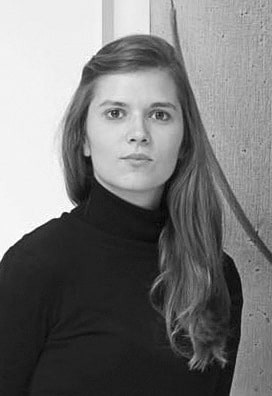 Astrid de Rendinger
Astrid de Rendinger
Art Advisor
Publications Manager / Catalogues raisonnés
(Gérard Schneider / Loïs Frederick)
astrid@dianedepolignac.com
 Aliénor Prouvost
Aliénor Prouvost
Art Advisor
Multimedia
alienor@dianedepolignac.com
Graphic Designer: Christian Demare
Translator: Jane Mac Avock
Printed by BB Créations
© Galerie Diane de Polignac – 2017
ISBN : 978-2-9548416-6-3 / dépôt légal septembre 2017
© ADAGP, Paris, sept. 2017
GALERIE DIANE DE POLIGNAC & CHAZOURNES
2 bis, rue de Gribeauval
75007 Paris – France
+ 33 (0) 1 83 06 79 90
Monday to Friday: 11 am to 7 pm
Saturday: 2 pm to 7 pm
